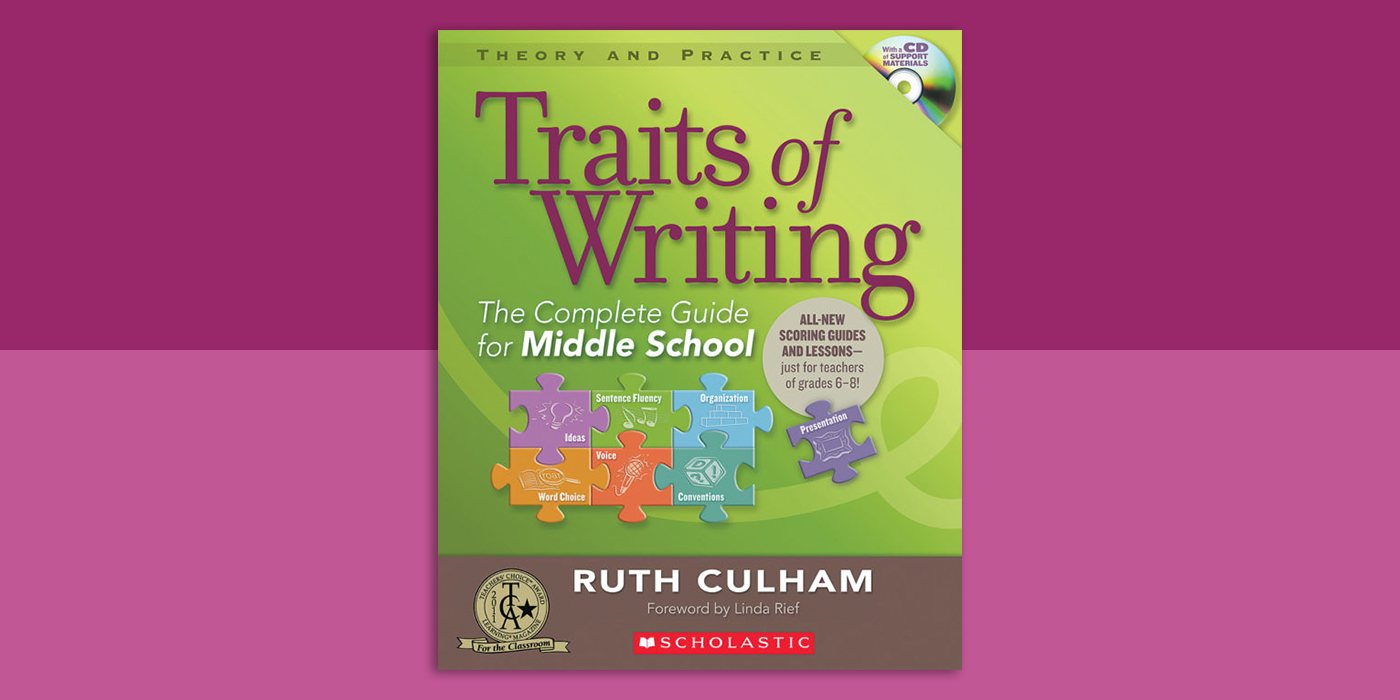

5 Secrets for Helping Middle School Writers Succeed
Even though I spent 19 years as a middle school teacher, I frequently ask myself what makes a middle school writing classroom work. I know successful teaching is a series of flexible moving parts. I know it’s one part inspiration and a bigger part organization. I know that every middle school teacher struggles to achieve more good days than bad.
In Traits of Writing: The Complete Guide for Middle School , I share meaningful and practical ideas for using what I’ve learned about teaching writing in middle school. My aim is to validate what you already know and give you new ways to support students. I also point out obstacles to watch out for and ways around them, so you don’t sacrifice the integrity of your teaching or the writing lives of your students.
As teachers, our greatest challenge may not be understanding best practices, but implementing those practices in classrooms where writing skills vary, time is precious, and the demand for high test scores can smother even the most creative teaching. But take heart. Teaching writing well is not impossible. Here are 5 secrets I know work in middle school and will help your young writers succeed:
1. The teacher must model how to learn.
If we want our students to write, we have to show them we are writers ourselves, which means opening ourselves up to scrutiny.
2. Learning should be infectious.
Look for inspiration everywhere and revise you lesson plans accordingly to foster a fascination with language, not just an understanding of terms. Who knows where this might lead?
3. Students must be active.
Engaging in lively activities, working in small groups, sitting on the floor, listening to music, using the computer, and talking about works in progress keep students moving, and therefore, learning.
4. Students will work hard if we give them rigorous, relevant tasks.
Let students take a giant leap forward and come up with their own projects and use the skills they have learned over the years to accomplish it. What they write matters less than the fact that they choose to write with such passion and determination.
5. Students deserve honest, detailed feedback.
Get serious about providing feedback. Students will appreciate your suggestions for making their writing smoother, clearer, and more interesting, and, like any serious writers, won’t always agree or follow them. But your students trust you to tell them the truth because they know your feedback, as difficult as it sometimes will be to convey, will help propel their work forward.
The secrets of writing, once locked away in the writing teacher’s vault, must be revealed and explored. How else will we sort out what works from what doesn’t? But you know this already. The writing lives of your middle school students depend on our getting it right.
To learn more about Traits of Writing: The Complete Guide for Middle School , you can purchase the book here.
About the author:
Ruth Culham, Ed.D., has published more than 40 best-selling professional books and resources with Scholastic and the International Literacy Association on the traits of writing and teaching writing using reading as a springboard to success. Her steadfast belief that every student is a writer is the hallmark of her work. As the author of Traits Writing: The Complete Writing Program for Grades K–8 (2012), she has launched a writing revolution. Traits Writing is the culmination of 40 years of educational experience, research, practice, and passion.
4 Activities to Help Middle School Students Uncover New Ideas for Writing
No matter how old you are, no matter how much writing you do, no matter how much you improve over time, finding ideas and writing about them clearly and compellingly is a challenge. Small wonder, then, that middle school writers find the ideas trait difficult to master.
Writing must make sense, and that’s what the ideas trait is all about—choosing a topic, narrowing it down, and supporting it with enough details to make the message clear and engaging. In Traits of Writing: The Complete Guide for Middle School , I outline the ideas trait’s 4 key qualities:
1. Finding a topic
2. Focusing the topic
3. Developing the topic
4. Using details
The following activities will help your students develop these qualities. Each is a creative, classroom-tested idea that allows students to try out skills and strategies that you share in warm-ups and focus lessons. These activities can take 5 minutes or 50, depending on your students’ needs and interest levels, and can be carried out by students independently or in small groups.
Finding a topic | Writer’s Notebooks
Often, the best topics are the ones students come up with themselves. As you work with students, encourage them to jot down in a notebook possible ideas for use in writing later—ideas that occur to them during science, social studies, health, fine arts, or English, or in everyday life. Let students select a notebook that makes them feel comfortable. Keep your own notebook and model how you jot down ideas for writing, words and phrases you like, intriguing information and observations, and questions to ponder.
Focusing the topic | The Best and the Worst Activity
Have your students brainstorm a list of real-world jobs that require a great deal of writing: a writer for a late-night talk show, a fund-raiser for a charity, a developer of video games, an author of children’s books, and so on. Write the jobs on a chart. Divide the class into small groups and assign one of the jobs to each group. Ask group members to prepare a panel presentation explaining the best and worst parts of the job and present it to the class, using some sort of visual aid that illustrates key points, such as a chart or diagram. Hang their creations in a prominent place for everyone to read and think about. This activity teaches students that writing is a big part of most professions—a lesson they will come to learn on their own soon enough.
Developing the topic | Top-Ten List
Ask students to write a top-ten list of things every adult should know about middle school students. Encourage them to develop each point in a fun, truthful, and interesting way. Here are examples of 2 developed points:
We don’t like to be told what to do. But if you don’t tell us, we won’t do it. And even when you do tell us, many times we don’t do it unless you get mean about it. We’re kinda flakey.
Remembering to put our names on our papers is harder than being blindfolded and sending a text message with our thumbs.
Using details | Getting Into the Details Activity
Give students a general statement, such as “I love Friday,” and ask them to work with a partner to brainstorm at least 10 details that explain why Friday is their favorite school day. Have pairs share those details with the whole class and make one long list. Now ask students to select their favorite details, at least 5 but no more than 10, and choose the one they consider the most important. From there, have pairs write a paragraph describing all the great things about Friday, emphasizing one detail they feel is most important. When they’re finished, ask students to put their paragraphs on their desks and invite their classmates to walk about and read them. Later, discuss the techniques students used to focus the reader’s attention on one detail more than others.
The time you spend teaching students where ideas come from and how to develop them effectively is critical to their success as writers. Finding a topic, focusing it, developing it, and using precise details to support it is where the writing begins.
Learn more about the ideas trait and other traits critical to writing success with Traits of Writing: The Complete Guide for Middle School . You can purchase the book here .

Essay Writing: A complete guide for students and teachers
P LANNING, PARAGRAPHING AND POLISHING: FINE-TUNING THE PERFECT ESSAY
Essay writing is an essential skill for every student. Whether writing a particular academic essay (such as persuasive, narrative, descriptive, or expository) or a timed exam essay, the key to getting good at writing is to write. Creating opportunities for our students to engage in extended writing activities will go a long way to helping them improve their skills as scribes.
But, putting the hours in alone will not be enough to attain the highest levels in essay writing. Practice must be meaningful. Once students have a broad overview of how to structure the various types of essays, they are ready to narrow in on the minor details that will enable them to fine-tune their work as a lean vehicle of their thoughts and ideas.

In this article, we will drill down to some aspects that will assist students in taking their essay writing skills up a notch. Many ideas and activities can be integrated into broader lesson plans based on essay writing. Often, though, they will work effectively in isolation – just as athletes isolate physical movements to drill that are relevant to their sport. When these movements become second nature, they can be repeated naturally in the context of the game or in our case, the writing of the essay.
THE ULTIMATE NONFICTION WRITING TEACHING RESOURCE

- 270 pages of the most effective teaching strategies
- 50+ digital tools ready right out of the box
- 75 editable resources for student differentiation
- Loads of tricks and tips to add to your teaching tool bag
- All explanations are reinforced with concrete examples.
- Links to high-quality video tutorials
- Clear objectives easy to match to the demands of your curriculum
Planning an essay

The Boys Scouts’ motto is famously ‘Be Prepared’. It’s a solid motto that can be applied to most aspects of life; essay writing is no different. Given the purpose of an essay is generally to present a logical and reasoned argument, investing time in organising arguments, ideas, and structure would seem to be time well spent.
Given that essays can take a wide range of forms and that we all have our own individual approaches to writing, it stands to reason that there will be no single best approach to the planning stage of essay writing. That said, there are several helpful hints and techniques we can share with our students to help them wrestle their ideas into a writable form. Let’s take a look at a few of the best of these:
BREAK THE QUESTION DOWN: UNDERSTAND YOUR ESSAY TOPIC.
Whether students are tackling an assignment that you have set for them in class or responding to an essay prompt in an exam situation, they should get into the habit of analyzing the nature of the task. To do this, they should unravel the question’s meaning or prompt. Students can practice this in class by responding to various essay titles, questions, and prompts, thereby gaining valuable experience breaking these down.
Have students work in groups to underline and dissect the keywords and phrases and discuss what exactly is being asked of them in the task. Are they being asked to discuss, describe, persuade, or explain? Understanding the exact nature of the task is crucial before going any further in the planning process, never mind the writing process .
BRAINSTORM AND MIND MAP WHAT YOU KNOW:
Once students have understood what the essay task asks them, they should consider what they know about the topic and, often, how they feel about it. When teaching essay writing, we so often emphasize that it is about expressing our opinions on things, but for our younger students what they think about something isn’t always obvious, even to themselves.
Brainstorming and mind-mapping what they know about a topic offers them an opportunity to uncover not just what they already know about a topic, but also gives them a chance to reveal to themselves what they think about the topic. This will help guide them in structuring their research and, later, the essay they will write . When writing an essay in an exam context, this may be the only ‘research’ the student can undertake before the writing, so practicing this will be even more important.
RESEARCH YOUR ESSAY
The previous step above should reveal to students the general direction their research will take. With the ubiquitousness of the internet, gone are the days of students relying on a single well-thumbed encyclopaedia from the school library as their sole authoritative source in their essay. If anything, the real problem for our students today is narrowing down their sources to a manageable number. Students should use the information from the previous step to help here. At this stage, it is important that they:
● Ensure the research material is directly relevant to the essay task
● Record in detail the sources of the information that they will use in their essay
● Engage with the material personally by asking questions and challenging their own biases
● Identify the key points that will be made in their essay
● Group ideas, counterarguments, and opinions together
● Identify the overarching argument they will make in their own essay.
Once these stages have been completed the student is ready to organise their points into a logical order.
WRITING YOUR ESSAY
There are a number of ways for students to organize their points in preparation for writing. They can use graphic organizers , post-it notes, or any number of available writing apps. The important thing for them to consider here is that their points should follow a logical progression. This progression of their argument will be expressed in the form of body paragraphs that will inform the structure of their finished essay.
The number of paragraphs contained in an essay will depend on a number of factors such as word limits, time limits, the complexity of the question etc. Regardless of the essay’s length, students should ensure their essay follows the Rule of Three in that every essay they write contains an introduction, body paragraphs, and a conclusion.
Generally speaking, essay paragraphs will focus on one main idea that is usually expressed in a topic sentence that is followed by a series of supporting sentences that bolster that main idea. The first and final sentences are of the most significance here with the first sentence of a paragraph making the point to the reader and the final sentence of the paragraph making the overall relevance to the essay’s argument crystal clear.
Though students will most likely be familiar with the broad generic structure of essays, it is worth investing time to ensure they have a clear conception of how each part of the essay works, that is, of the exact nature of the task it performs. Let’s review:
Common Essay Structure
Introduction: Provides the reader with context for the essay. It states the broad argument that the essay will make and informs the reader of the writer’s general perspective and approach to the question.
Body Paragraphs: These are the ‘meat’ of the essay and lay out the argument stated in the introduction point by point with supporting evidence.
Conclusion: Usually, the conclusion will restate the central argument while summarising the essay’s main supporting reasons before linking everything back to the original question.
ESSAY WRITING PARAGRAPH WRITING TIPS

● Each paragraph should focus on a single main idea
● Paragraphs should follow a logical sequence; students should group similar ideas together to avoid incoherence
● Paragraphs should be denoted consistently; students should choose either to indent or skip a line
● Transition words and phrases such as alternatively , consequently , in contrast should be used to give flow and provide a bridge between paragraphs.
HOW TO EDIT AN ESSAY

Students shouldn’t expect their essays to emerge from the writing process perfectly formed. Except in exam situations and the like, thorough editing is an essential aspect in the writing process.
Often, students struggle with this aspect of the process the most. After spending hours of effort on planning, research, and writing the first draft, students can be reluctant to go back over the same terrain they have so recently travelled. It is important at this point to give them some helpful guidelines to help them to know what to look out for. The following tips will provide just such help:
One Piece at a Time: There is a lot to look out for in the editing process and often students overlook aspects as they try to juggle too many balls during the process. One effective strategy to combat this is for students to perform a number of rounds of editing with each focusing on a different aspect. For example, the first round could focus on content, the second round on looking out for word repetition (use a thesaurus to help here), with the third attending to spelling and grammar.
Sum It Up: When reviewing the paragraphs they have written, a good starting point is for students to read each paragraph and attempt to sum up its main point in a single line. If this is not possible, their readers will most likely have difficulty following their train of thought too and the paragraph needs to be overhauled.
Let It Breathe: When possible, encourage students to allow some time for their essay to ‘breathe’ before returning to it for editing purposes. This may require some skilful time management on the part of the student, for example, a student rush-writing the night before the deadline does not lend itself to effective editing. Fresh eyes are one of the sharpest tools in the writer’s toolbox.
Read It Aloud: This time-tested editing method is a great way for students to identify mistakes and typos in their work. We tend to read things more slowly when reading aloud giving us the time to spot errors. Also, when we read silently our minds can often fill in the gaps or gloss over the mistakes that will become apparent when we read out loud.
Phone a Friend: Peer editing is another great way to identify errors that our brains may miss when reading our own work. Encourage students to partner up for a little ‘you scratch my back, I scratch yours’.
Use Tech Tools: We need to ensure our students have the mental tools to edit their own work and for this they will need a good grasp of English grammar and punctuation. However, there are also a wealth of tech tools such as spellcheck and grammar checks that can offer a great once-over option to catch anything students may have missed in earlier editing rounds.

Putting the Jewels on Display: While some struggle to edit, others struggle to let go. There comes a point when it is time for students to release their work to the reader. They must learn to relinquish control after the creation is complete. This will be much easier to achieve if the student feels that they have done everything in their control to ensure their essay is representative of the best of their abilities and if they have followed the advice here, they should be confident they have done so.
WRITING CHECKLISTS FOR ALL TEXT TYPES

ESSAY WRITING video tutorials

- Share full article
Advertisement
Supported by
Our 2020-21 Writing Curriculum for Middle and High School
A flexible, seven-unit program based on the real-world writing found in newspapers, from editorials and reviews to personal narratives and informational essays.

Update, Aug. 3, 2023: Find our 2023-24 writing curriculum here.
Our 2019-20 Writing Curriculum is one of the most popular new features we’ve ever run on this site, so, of course, we’re back with a 2020-21 version — one we hope is useful whether you’re teaching in person , online , indoors , outdoors , in a pod , as a homeschool , or in some hybrid of a few of these.
The curriculum detailed below is both a road map for teachers and an invitation to students. For teachers, it includes our writing prompts, mentor texts, contests and lesson plans, and organizes them all into seven distinct units. Each focuses on a different genre of writing that you can find not just in The Times but also in all kinds of real-world sources both in print and online.
But for students, our main goal is to show young people they have something valuable to say, and to give those voices a global audience. That’s always been a pillar of our site, but this year it is even more critical. The events of 2020 will define this generation, and many are living through them isolated from their ordinary communities, rituals and supports. Though a writing curriculum can hardly make up for that, we hope that it can at least offer teenagers a creative outlet for making sense of their experiences, and an enthusiastic audience for the results. Through the opportunities for publication woven throughout each unit, we want to encourage students to go beyond simply being media consumers to become creators and contributors themselves.
So have a look, and see if you can find a way to include any of these opportunities in your curriculum this year, whether to help students document their lives, tell stories, express opinions, investigate ideas, or analyze culture. We can’t wait to hear what your students have to say!
Each unit includes:
Writing prompts to help students try out related skills in a “low stakes” way.
We publish two writing prompts every school day, and we also have thematic collections of more than 1,000 prompts published in the past. Your students might consider responding to these prompts on our site and using our public forums as a kind of “rehearsal space” for practicing voice and technique.
Daily opportunities to practice writing for an authentic audience.
If a student submits a comment on our site, it will be read by Times editors, who approve each one before it gets published. Submitting a comment also gives students an audience of fellow teenagers from around the world who might read and respond to their work. Each week, we call out our favorite comments and honor dozens of students by name in our Thursday “ Current Events Conversation ” feature.
Guided practice with mentor texts .
Each unit we publish features guided practice lessons, written directly to students, that help them observe, understand and practice the kinds of “craft moves” that make different genres of writing sing. From how to “show not tell” in narratives to how to express critical opinions , quote or paraphrase experts or craft scripts for podcasts , we have used the work of both Times journalists and the teenage winners of our contests to show students techniques they can emulate.
“Annotated by the Author” commentaries from Times writers — and teenagers.
As part of our Mentor Texts series , we’ve been asking Times journalists from desks across the newsroom to annotate their articles to let students in on their writing, research and editing processes, and we’ll be adding more for each unit this year. Whether it’s Science writer Nicholas St. Fleur on tiny tyrannosaurs , Opinion writer Aisha Harris on the cultural canon , or The Times’s comics-industry reporter, George Gene Gustines, on comic books that celebrate pride , the idea is to demystify journalism for teenagers. This year, we’ll be inviting student winners of our contests to annotate their work as well.
A contest that can act as a culminating project .
Over the years we’ve heard from many teachers that our contests serve as final projects in their classes, and this curriculum came about in large part because we want to help teachers “plan backwards” to support those projects.
All contest entries are considered by experts, whether Times journalists, outside educators from partner organizations, or professional practitioners in a related field. Winning means being published on our site, and, perhaps, in the print edition of The New York Times.
Webinars and our new professional learning community (P.L.C.).
For each of the seven units in this curriculum, we host a webinar featuring Learning Network editors as well as teachers who use The Times in their classrooms. Our webinars introduce participants to our many resources and provide practical how-to’s on how to use our prompts, mentor texts and contests in the classroom.
New for this school year, we also invite teachers to join our P.L.C. on teaching writing with The Times , where educators can share resources, strategies and inspiration about teaching with these units.
Below are the seven units we will offer in the 2020-21 school year.
September-October
Unit 1: Documenting Teenage Lives in Extraordinary Times
This special unit acknowledges both the tumultuous events of 2020 and their outsized impact on young people — and invites teenagers to respond creatively. How can they add their voices to our understanding of what this historic year will mean for their generation?
Culminating in our Coming of Age in 2020 contest, the unit helps teenagers document and respond to what it’s been like to live through what one Times article describes as “a year of tragedy, of catastrophe, of upheaval, a year that has inflicted one blow after another, a year that has filled the morgues, emptied the schools, shuttered the workplaces, swelled the unemployment lines and polarized the electorate.”
A series of writing prompts, mentor texts and a step-by-step guide will help them think deeply and analytically about who they are, how this year has impacted them, what they’d like to express as a result, and how they’d like to express it. How might they tell their unique stories in ways that feel meaningful and authentic, whether those stories are serious or funny, big or small, raw or polished?
Though the contest accepts work across genres — via words and images, video and audio — all students will also craft written artist’s statements for each piece they submit. In addition, no matter what genre of work students send in, the unit will use writing as a tool throughout to help students brainstorm, compose and edit. And, of course, this work, whether students send it to us or not, is valuable far beyond the classroom: Historians, archivists and museums recommend that we all document our experiences this year, if only for ourselves.
October-November
Unit 2: The Personal Narrative
While The Times is known for its award-winning journalism, the paper also has a robust tradition of publishing personal essays on topics like love , family , life on campus and navigating anxiety . And on our site, our daily writing prompts have long invited students to tell us their stories, too. Our 2019 collection of 550 Prompts for Narrative and Personal Writing is a good place to start, though we add more every week during the school year.
In this unit we draw on many of these resources, plus some of the 1,000-plus personal essays from the Magazine’s long-running Lives column , to help students find their own “short, memorable stories ” and tell them well. Our related mentor-text lessons can help them practice skills like writing with voice , using details to show rather than tell , structuring a narrative arc , dropping the reader into a scene and more. This year, we’ll also be including mentor text guided lessons that use the work of the 2019 student winners.
As a final project, we invite students to send finished stories to our Second Annual Personal Narrative Writing Contest .
DECEMBER-January
Unit 3: The Review
Book reports and literary essays have long been staples of language arts classrooms, but this unit encourages students to learn how to critique art in other genres as well. As we point out, a cultural review is, of course, a form of argumentative essay. Your class might be writing about Lizzo or “ Looking for Alaska ,” but they still have to make claims and support them with evidence. And, just as they must in a literature essay, they have to read (or watch, or listen to) a work closely; analyze it and understand its context; and explain what is meaningful and interesting about it.
In our Mentor Texts series , we feature the work of Times movie , restaurant , book and music critics to help students understand the elements of a successful review. In each one of these guided lessons, we also spotlight the work of teenage contest winners from previous years.
As a culminating project, we invite students to send us their own reviews of a book, movie, restaurant, album, theatrical production, video game, dance performance, TV show, art exhibition or any other kind of work The Times critiques.
January-February
Unit 4: Informational Writing
Informational writing is the style of writing that dominates The New York Times as well as any other traditional newspaper you might read, and in this unit we hope to show students that it can be every bit as engaging and compelling to read and to write as other genres. Via thousands of articles a month — from front-page reporting on politics to news about athletes in Sports, deep data dives in The Upshot, recipes in Cooking, advice columns in Style and long-form investigative pieces in the magazine — Times journalists find ways to experiment with the genre to intrigue and inform their audiences.
This unit invites students to take any STEM-related discovery, process or idea that interests them and write about it in a way that makes it understandable and engaging for a general audience — but all the skills we teach along the way can work for any kind of informational writing. Via our Mentor Texts series, we show them how to hook the reader from the start , use quotes and research , explain why a topic matters and more. This year we’ll be using the work of the 2020 student winners for additional mentor text lessons.
At the end of the unit, we invite teenagers to submit their own writing to our Second Annual STEM writing contest to show us what they’ve learned.
March-April
Unit 5: Argumentative Writing
The demand for evidence-based argumentative writing is now woven into school assignments across the curriculum and grade levels, and you couldn’t ask for better real-world examples than what you can find in The Times Opinion section .
This unit will, like our others, be supported with writing prompts, mentor-text lesson plans, webinars and more. We’ll also focus on the winning teenage writing we’ve received over the six years we’ve run our related contest.
At a time when media literacy is more important than ever, we also hope that our annual Student Editorial Contest can serve as a final project that encourages students to broaden their information diets with a range of reliable sources, and learn from a variety of perspectives on their chosen issue.
To help students working from home, we also have an Argumentative Unit for Students Doing Remote Learning .
Unit 6: Writing for Podcasts
Most of our writing units so far have all asked for essays of one kind or another, but this spring contest invites students to do what journalists at The Times do every day: make multimedia to tell a story, investigate an issue or communicate a concept.
Our annual podcast contest gives students the freedom to talk about anything they want in any form they like. In the past we’ve had winners who’ve done personal narratives, local travelogues, opinion pieces, interviews with community members, local investigative journalism and descriptions of scientific discoveries.
As with all our other units, we have supported this contest with great examples from The Times and around the web, as well as with mentor texts by teenagers that offer guided practice in understanding elements and techniques.
June-August
Unit 7: Independent Reading and Writing
At a time when teachers are looking for ways to offer students more “voice and choice,” this unit, based on our annual summer contest, offers both.
Every year since 2010 we have invited teenagers around the world to add The New York Times to their summer reading lists and, so far, 70,000 have. Every week for 10 weeks, we ask participants to choose something in The Times that has sparked their interest, then tell us why. At the end of the week, judges from the Times newsroom pick favorite responses, and we publish them on our site.
And we’ve used our Mentor Text feature to spotlight the work of past winners , explain why newsroom judges admired their thinking, and provide four steps to helping any student write better reader-responses.
Because this is our most open-ended contest — students can choose whatever they like, and react however they like — it has proved over the years to be a useful place for young writers to hone their voices, practice skills and take risks . Join us!
Classroom Q&A
With larry ferlazzo.
In this EdWeek blog, an experiment in knowledge-gathering, Ferlazzo will address readers’ questions on classroom management, ELL instruction, lesson planning, and other issues facing teachers. Send your questions to [email protected]. Read more from this blog.
Four Strategies for Effective Writing Instruction

- Share article
(This is the first post in a two-part series.)
The new question-of-the-week is:
What is the single most effective instructional strategy you have used to teach writing?
Teaching and learning good writing can be a challenge to educators and students alike.
The topic is no stranger to this column—you can see many previous related posts at Writing Instruction .
But I don’t think any of us can get too much good instructional advice in this area.
Today, Jenny Vo, Michele Morgan, and Joy Hamm share wisdom gained from their teaching experience.
Before I turn over the column to them, though, I’d like to share my favorite tool(s).
Graphic organizers, including writing frames (which are basically more expansive sentence starters) and writing structures (which function more as guides and less as “fill-in-the-blanks”) are critical elements of my writing instruction.
You can see an example of how I incorporate them in my seven-week story-writing unit and in the adaptations I made in it for concurrent teaching.
You might also be interested in The Best Scaffolded Writing Frames For Students .
Now, to today’s guests:
‘Shared Writing’
Jenny Vo earned her B.A. in English from Rice University and her M.Ed. in educational leadership from Lamar University. She has worked with English-learners during all of her 24 years in education and is currently an ESL ISST in Katy ISD in Katy, Texas. Jenny is the president-elect of TexTESOL IV and works to advocate for all ELs:
The single most effective instructional strategy that I have used to teach writing is shared writing. Shared writing is when the teacher and students write collaboratively. In shared writing, the teacher is the primary holder of the pen, even though the process is a collaborative one. The teacher serves as the scribe, while also questioning and prompting the students.
The students engage in discussions with the teacher and their peers on what should be included in the text. Shared writing can be done with the whole class or as a small-group activity.
There are two reasons why I love using shared writing. One, it is a great opportunity for the teacher to model the structures and functions of different types of writing while also weaving in lessons on spelling, punctuation, and grammar.
It is a perfect activity to do at the beginning of the unit for a new genre. Use shared writing to introduce the students to the purpose of the genre. Model the writing process from beginning to end, taking the students from idea generation to planning to drafting to revising to publishing. As you are writing, make sure you refrain from making errors, as you want your finished product to serve as a high-quality model for the students to refer back to as they write independently.
Another reason why I love using shared writing is that it connects the writing process with oral language. As the students co-construct the writing piece with the teacher, they are orally expressing their ideas and listening to the ideas of their classmates. It gives them the opportunity to practice rehearsing what they are going to say before it is written down on paper. Shared writing gives the teacher many opportunities to encourage their quieter or more reluctant students to engage in the discussion with the types of questions the teacher asks.
Writing well is a skill that is developed over time with much practice. Shared writing allows students to engage in the writing process while observing the construction of a high-quality sample. It is a very effective instructional strategy used to teach writing.

‘Four Square’
Michele Morgan has been writing IEPs and behavior plans to help students be more successful for 17 years. She is a national-board-certified teacher, Utah Teacher Fellow with Hope Street Group, and a special education elementary new-teacher specialist with the Granite school district. Follow her @MicheleTMorgan1:
For many students, writing is the most dreaded part of the school day. Writing involves many complex processes that students have to engage in before they produce a product—they must determine what they will write about, they must organize their thoughts into a logical sequence, and they must do the actual writing, whether on a computer or by hand. Still they are not done—they must edit their writing and revise mistakes. With all of that, it’s no wonder that students struggle with writing assignments.
In my years working with elementary special education students, I have found that writing is the most difficult subject to teach. Not only do my students struggle with the writing process, but they often have the added difficulties of not knowing how to spell words and not understanding how to use punctuation correctly. That is why the single most effective strategy I use when teaching writing is the Four Square graphic organizer.
The Four Square instructional strategy was developed in 1999 by Judith S. Gould and Evan Jay Gould. When I first started teaching, a colleague allowed me to borrow the Goulds’ book about using the Four Square method, and I have used it ever since. The Four Square is a graphic organizer that students can make themselves when given a blank sheet of paper. They fold it into four squares and draw a box in the middle of the page. The genius of this instructional strategy is that it can be used by any student, in any grade level, for any writing assignment. These are some of the ways I have used this strategy successfully with my students:
* Writing sentences: Students can write the topic for the sentence in the middle box, and in each square, they can draw pictures of details they want to add to their writing.
* Writing paragraphs: Students write the topic sentence in the middle box. They write a sentence containing a supporting detail in three of the squares and they write a concluding sentence in the last square.
* Writing short essays: Students write what information goes in the topic paragraph in the middle box, then list details to include in supporting paragraphs in the squares.
When I gave students writing assignments, the first thing I had them do was create a Four Square. We did this so often that it became automatic. After filling in the Four Square, they wrote rough drafts by copying their work off of the graphic organizer and into the correct format, either on lined paper or in a Word document. This worked for all of my special education students!
I was able to modify tasks using the Four Square so that all of my students could participate, regardless of their disabilities. Even if they did not know what to write about, they knew how to start the assignment (which is often the hardest part of getting it done!) and they grew to be more confident in their writing abilities.
In addition, when it was time to take the high-stakes state writing tests at the end of the year, this was a strategy my students could use to help them do well on the tests. I was able to give them a sheet of blank paper, and they knew what to do with it. I have used many different curriculum materials and programs to teach writing in the last 16 years, but the Four Square is the one strategy that I have used with every writing assignment, no matter the grade level, because it is so effective.

‘Swift Structures’
Joy Hamm has taught 11 years in a variety of English-language settings, ranging from kindergarten to adult learners. The last few years working with middle and high school Newcomers and completing her M.Ed in TESOL have fostered stronger advocacy in her district and beyond:
A majority of secondary content assessments include open-ended essay questions. Many students falter (not just ELs) because they are unaware of how to quickly organize their thoughts into a cohesive argument. In fact, the WIDA CAN DO Descriptors list level 5 writing proficiency as “organizing details logically and cohesively.” Thus, the most effective cross-curricular secondary writing strategy I use with my intermediate LTELs (long-term English-learners) is what I call “Swift Structures.” This term simply means reading a prompt across any content area and quickly jotting down an outline to organize a strong response.
To implement Swift Structures, begin by displaying a prompt and modeling how to swiftly create a bubble map or outline beginning with a thesis/opinion, then connecting the three main topics, which are each supported by at least three details. Emphasize this is NOT the time for complete sentences, just bulleted words or phrases.
Once the outline is completed, show your ELs how easy it is to plug in transitions, expand the bullets into detailed sentences, and add a brief introduction and conclusion. After modeling and guided practice, set a 5-10 minute timer and have students practice independently. Swift Structures is one of my weekly bell ringers, so students build confidence and skill over time. It is best to start with easy prompts where students have preformed opinions and knowledge in order to focus their attention on the thesis-topics-supporting-details outline, not struggling with the rigor of a content prompt.
Here is one easy prompt example: “Should students be allowed to use their cellphones in class?”
Swift Structure outline:
Thesis - Students should be allowed to use cellphones because (1) higher engagement (2) learning tools/apps (3) gain 21st-century skills
Topic 1. Cellphones create higher engagement in students...
Details A. interactive (Flipgrid, Kahoot)
B. less tempted by distractions
C. teaches responsibility
Topic 2. Furthermore,...access to learning tools...
A. Google Translate description
B. language practice (Duolingo)
C. content tutorials (Kahn Academy)
Topic 3. In addition,...practice 21st-century skills…
Details A. prep for workforce
B. access to information
C. time-management support
This bare-bones outline is like the frame of a house. Get the structure right, and it’s easier to fill in the interior decorating (style, grammar), roof (introduction) and driveway (conclusion). Without the frame, the roof and walls will fall apart, and the reader is left confused by circuitous rubble.
Once LTELs have mastered creating simple Swift Structures in less than 10 minutes, it is time to introduce complex questions similar to prompts found on content assessments or essays. Students need to gain assurance that they can quickly and logically explain and justify their opinions on multiple content essays without freezing under pressure.

Thanks to Jenny, Michele, and Joy for their contributions!
Please feel free to leave a comment with your reactions to the topic or directly to anything that has been said in this post.
Consider contributing a question to be answered in a future post. You can send one to me at [email protected] . When you send it in, let me know if I can use your real name if it’s selected or if you’d prefer remaining anonymous and have a pseudonym in mind.
You can also contact me on Twitter at @Larryferlazzo .
Education Week has published a collection of posts from this blog, along with new material, in an e-book form. It’s titled Classroom Management Q&As: Expert Strategies for Teaching .
Just a reminder; you can subscribe and receive updates from this blog via email (The RSS feed for this blog, and for all Ed Week articles, has been changed by the new redesign—new ones are not yet available). And if you missed any of the highlights from the first nine years of this blog, you can see a categorized list below.
- This Year’s Most Popular Q&A Posts
- Race & Racism in Schools
- School Closures & the Coronavirus Crisis
- Classroom-Management Advice
- Best Ways to Begin the School Year
- Best Ways to End the School Year
- Student Motivation & Social-Emotional Learning
- Implementing the Common Core
- Facing Gender Challenges in Education
- Teaching Social Studies
- Cooperative & Collaborative Learning
- Using Tech in the Classroom
- Student Voices
- Parent Engagement in Schools
- Teaching English-Language Learners
- Reading Instruction
- Writing Instruction
- Education Policy Issues
- Differentiating Instruction
- Math Instruction
- Science Instruction
- Advice for New Teachers
- Author Interviews
- Entering the Teaching Profession
- The Inclusive Classroom
- Learning & the Brain
- Administrator Leadership
- Teacher Leadership
- Relationships in Schools
- Professional Development
- Instructional Strategies
- Best of Classroom Q&A
- Professional Collaboration
- Classroom Organization
- Mistakes in Education
- Project-Based Learning
I am also creating a Twitter list including all contributors to this column .
The opinions expressed in Classroom Q&A With Larry Ferlazzo are strictly those of the author(s) and do not reflect the opinions or endorsement of Editorial Projects in Education, or any of its publications.
Sign Up for EdWeek Update
Edweek top school jobs.

Sign Up & Sign In

- CORE CURRICULUM
- LITERACY > CORE CURRICULUM > Into Literature, 6-12" data-element-type="header nav submenu" title="Into Literature, 6-12" aria-label="Into Literature, 6-12"> Into Literature, 6-12
- LITERACY > CORE CURRICULUM > Into Reading, K-6" data-element-type="header nav submenu" title="Into Reading, K-6" aria-label="Into Reading, K-6"> Into Reading, K-6
- INTERVENTION
- LITERACY > INTERVENTION > English 3D, 4-12" data-element-type="header nav submenu" title="English 3D, 4-12" aria-label="English 3D, 4-12"> English 3D, 4-12
- LITERACY > INTERVENTION > Read 180, 3-12" data-element-type="header nav submenu" title="Read 180, 3-12" aria-label="Read 180, 3-12"> Read 180, 3-12
- LITERACY > READERS > Hero Academy Leveled Libraries, PreK-4" data-element-type="header nav submenu" title="Hero Academy Leveled Libraries, PreK-4" aria-label="Hero Academy Leveled Libraries, PreK-4"> Hero Academy Leveled Libraries, PreK-4
- LITERACY > READERS > HMH Reads Digital Library, K-5" data-element-type="header nav submenu" title="HMH Reads Digital Library, K-5" aria-label="HMH Reads Digital Library, K-5"> HMH Reads Digital Library, K-5
- LITERACY > READERS > inFact Leveled Libraries, K-5" data-element-type="header nav submenu" title="inFact Leveled Libraries, K-5" aria-label="inFact Leveled Libraries, K-5"> inFact Leveled Libraries, K-5
- LITERACY > READERS > Rigby PM, K-5" data-element-type="header nav submenu" title="Rigby PM, K-5" aria-label="Rigby PM, K-5"> Rigby PM, K-5
- LITERACY > READERS > Science & Engineering Leveled Readers, K-5" data-element-type="header nav submenu" title="Science & Engineering Leveled Readers, K-5" aria-label="Science & Engineering Leveled Readers, K-5"> Science & Engineering Leveled Readers, K-5
- SUPPLEMENTAL
- LITERACY > SUPPLEMENTAL > A Chance in the World SEL, 8-12" data-element-type="header nav submenu" title="A Chance in the World SEL, 8-12" aria-label="A Chance in the World SEL, 8-12"> A Chance in the World SEL, 8-12
- LITERACY > SUPPLEMENTAL > Amira Learning, K-6" data-element-type="header nav submenu" title="Amira Learning, K-6" aria-label="Amira Learning, K-6"> Amira Learning, K-6
- LITERACY > SUPPLEMENTAL > Classcraft, K-8" data-element-type="header nav submenu" title="Classcraft, K-8" aria-label="Classcraft, K-8"> Classcraft, K-8
- LITERACY > SUPPLEMENTAL > JillE Literacy, K-3" data-element-type="header nav submenu" title="JillE Literacy, K-3" aria-label="JillE Literacy, K-3"> JillE Literacy, K-3
- LITERACY > SUPPLEMENTAL > Waggle, K-8" data-element-type="header nav submenu" title="Waggle, K-8" aria-label="Waggle, K-8"> Waggle, K-8
- LITERACY > SUPPLEMENTAL > Writable, 3-12" data-element-type="header nav submenu" title="Writable, 3-12" aria-label="Writable, 3-12"> Writable, 3-12
- LITERACY > SUPPLEMENTAL > ASSESSMENT" data-element-type="header nav submenu" title="ASSESSMENT" aria-label="ASSESSMENT"> ASSESSMENT
- MATH > CORE CURRICULUM > Arriba las Matematicas, K-8" data-element-type="header nav submenu" title="Arriba las Matematicas, K-8" aria-label="Arriba las Matematicas, K-8"> Arriba las Matematicas, K-8
- MATH > CORE CURRICULUM > Go Math!, K-6" data-element-type="header nav submenu" title="Go Math!, K-6" aria-label="Go Math!, K-6"> Go Math!, K-6
- MATH > CORE CURRICULUM > Into Algebra 1, Geometry, Algebra 2, 8-12" data-element-type="header nav submenu" title="Into Algebra 1, Geometry, Algebra 2, 8-12" aria-label="Into Algebra 1, Geometry, Algebra 2, 8-12"> Into Algebra 1, Geometry, Algebra 2, 8-12
- MATH > CORE CURRICULUM > Into Math, K-8" data-element-type="header nav submenu" title="Into Math, K-8" aria-label="Into Math, K-8"> Into Math, K-8
- MATH > CORE CURRICULUM > Math Expressions, PreK-6" data-element-type="header nav submenu" title="Math Expressions, PreK-6" aria-label="Math Expressions, PreK-6"> Math Expressions, PreK-6
- MATH > CORE CURRICULUM > Math in Focus, K-8" data-element-type="header nav submenu" title="Math in Focus, K-8" aria-label="Math in Focus, K-8"> Math in Focus, K-8
- MATH > SUPPLEMENTAL > Classcraft, K-8" data-element-type="header nav submenu" title="Classcraft, K-8" aria-label="Classcraft, K-8"> Classcraft, K-8
- MATH > SUPPLEMENTAL > Waggle, K-8" data-element-type="header nav submenu" title="Waggle, K-8" aria-label="Waggle, K-8"> Waggle, K-8
- MATH > INTERVENTION > Math 180, 5-12" data-element-type="header nav submenu" title="Math 180, 5-12" aria-label="Math 180, 5-12"> Math 180, 5-12
- SCIENCE > CORE CURRICULUM > Into Science, K-5" data-element-type="header nav submenu" title="Into Science, K-5" aria-label="Into Science, K-5"> Into Science, K-5
- SCIENCE > CORE CURRICULUM > Into Science, 6-8" data-element-type="header nav submenu" title="Into Science, 6-8" aria-label="Into Science, 6-8"> Into Science, 6-8
- SCIENCE > CORE CURRICULUM > Science Dimensions, K-12" data-element-type="header nav submenu" title="Science Dimensions, K-12" aria-label="Science Dimensions, K-12"> Science Dimensions, K-12
- SCIENCE > READERS > inFact Leveled Readers, K-5" data-element-type="header nav submenu" title="inFact Leveled Readers, K-5" aria-label="inFact Leveled Readers, K-5"> inFact Leveled Readers, K-5
- SCIENCE > READERS > Science & Engineering Leveled Readers, K-5" data-element-type="header nav submenu" title="Science & Engineering Leveled Readers, K-5" aria-label="Science & Engineering Leveled Readers, K-5"> Science & Engineering Leveled Readers, K-5
- SCIENCE > READERS > ScienceSaurus, K-8" data-element-type="header nav submenu" title="ScienceSaurus, K-8" aria-label="ScienceSaurus, K-8"> ScienceSaurus, K-8
- SOCIAL STUDIES > CORE CURRICULUM > HMH Social Studies, 6-12" data-element-type="header nav submenu" title="HMH Social Studies, 6-12" aria-label="HMH Social Studies, 6-12"> HMH Social Studies, 6-12
- SOCIAL STUDIES > SUPPLEMENTAL > Writable" data-element-type="header nav submenu" title="Writable" aria-label="Writable"> Writable
- For Teachers
- PROFESSIONAL DEVELOPMENT > For Teachers > Coachly" data-element-type="header nav submenu" title="Coachly" aria-label="Coachly"> Coachly
- PROFESSIONAL DEVELOPMENT > For Teachers > Teacher's Corner" data-element-type="header nav submenu" title="Teacher's Corner" aria-label="Teacher's Corner"> Teacher's Corner
- PROFESSIONAL DEVELOPMENT > For Teachers > Live Online Courses" data-element-type="header nav submenu" title="Live Online Courses" aria-label="Live Online Courses"> Live Online Courses
- For Leaders
- PROFESSIONAL DEVELOPMENT > For Leaders > The Center for Model Schools (formerly ICLE)" data-element-type="header nav submenu" title="The Center for Model Schools (formerly ICLE)" aria-label="The Center for Model Schools (formerly ICLE)"> The Center for Model Schools (formerly ICLE)
- MORE > undefined > Assessment" data-element-type="header nav submenu" title="Assessment" aria-label="Assessment"> Assessment
- MORE > undefined > Early Learning" data-element-type="header nav submenu" title="Early Learning" aria-label="Early Learning"> Early Learning
- MORE > undefined > English Language Development" data-element-type="header nav submenu" title="English Language Development" aria-label="English Language Development"> English Language Development
- MORE > undefined > Homeschool" data-element-type="header nav submenu" title="Homeschool" aria-label="Homeschool"> Homeschool
- MORE > undefined > Intervention" data-element-type="header nav submenu" title="Intervention" aria-label="Intervention"> Intervention
- MORE > undefined > Literacy" data-element-type="header nav submenu" title="Literacy" aria-label="Literacy"> Literacy
- MORE > undefined > Mathematics" data-element-type="header nav submenu" title="Mathematics" aria-label="Mathematics"> Mathematics
- MORE > undefined > Professional Development" data-element-type="header nav submenu" title="Professional Development" aria-label="Professional Development"> Professional Development
- MORE > undefined > Science" data-element-type="header nav submenu" title="Science" aria-label="Science"> Science
- MORE > undefined > undefined" data-element-type="header nav submenu">
- MORE > undefined > Social and Emotional Learning" data-element-type="header nav submenu" title="Social and Emotional Learning" aria-label="Social and Emotional Learning"> Social and Emotional Learning
- MORE > undefined > Social Studies" data-element-type="header nav submenu" title="Social Studies" aria-label="Social Studies"> Social Studies
- MORE > undefined > Special Education" data-element-type="header nav submenu" title="Special Education" aria-label="Special Education"> Special Education
- MORE > undefined > Summer School" data-element-type="header nav submenu" title="Summer School" aria-label="Summer School"> Summer School
- BROWSE RESOURCES
- BROWSE RESOURCES > Classroom Activities" data-element-type="header nav submenu" title="Classroom Activities" aria-label="Classroom Activities"> Classroom Activities
- BROWSE RESOURCES > Customer Success Stories" data-element-type="header nav submenu" title="Customer Success Stories" aria-label="Customer Success Stories"> Customer Success Stories
- BROWSE RESOURCES > Digital Samples" data-element-type="header nav submenu" title="Digital Samples" aria-label="Digital Samples"> Digital Samples
- BROWSE RESOURCES > Events" data-element-type="header nav submenu" title="Events" aria-label="Events"> Events
- BROWSE RESOURCES > Grants & Funding" data-element-type="header nav submenu" title="Grants & Funding" aria-label="Grants & Funding"> Grants & Funding
- BROWSE RESOURCES > International" data-element-type="header nav submenu" title="International" aria-label="International"> International
- BROWSE RESOURCES > Research Library" data-element-type="header nav submenu" title="Research Library" aria-label="Research Library"> Research Library
- BROWSE RESOURCES > Shaped - HMH Blog" data-element-type="header nav submenu" title="Shaped - HMH Blog" aria-label="Shaped - HMH Blog"> Shaped - HMH Blog
- BROWSE RESOURCES > Webinars" data-element-type="header nav submenu" title="Webinars" aria-label="Webinars"> Webinars
- CUSTOMER SUPPORT
- CUSTOMER SUPPORT > Contact Sales" data-element-type="header nav submenu" title="Contact Sales" aria-label="Contact Sales"> Contact Sales
- CUSTOMER SUPPORT > Customer Service & Technical Support Portal" data-element-type="header nav submenu" title="Customer Service & Technical Support Portal" aria-label="Customer Service & Technical Support Portal"> Customer Service & Technical Support Portal
- CUSTOMER SUPPORT > Platform Login" data-element-type="header nav submenu" title="Platform Login" aria-label="Platform Login"> Platform Login
- Learn about us
- Learn about us > About" data-element-type="header nav submenu" title="About" aria-label="About"> About
- Learn about us > Diversity, Equity, and Inclusion" data-element-type="header nav submenu" title="Diversity, Equity, and Inclusion" aria-label="Diversity, Equity, and Inclusion"> Diversity, Equity, and Inclusion
- Learn about us > Environmental, Social, and Governance" data-element-type="header nav submenu" title="Environmental, Social, and Governance" aria-label="Environmental, Social, and Governance"> Environmental, Social, and Governance
- Learn about us > News Announcements" data-element-type="header nav submenu" title="News Announcements" aria-label="News Announcements"> News Announcements
- Learn about us > Our Legacy" data-element-type="header nav submenu" title="Our Legacy" aria-label="Our Legacy"> Our Legacy
- Learn about us > Social Responsibility" data-element-type="header nav submenu" title="Social Responsibility" aria-label="Social Responsibility"> Social Responsibility
- Learn about us > Supplier Diversity" data-element-type="header nav submenu" title="Supplier Diversity" aria-label="Supplier Diversity"> Supplier Diversity
- Join Us > Careers" data-element-type="header nav submenu" title="Careers" aria-label="Careers"> Careers
- Join Us > Educator Input Panel" data-element-type="header nav submenu" title="Educator Input Panel" aria-label="Educator Input Panel"> Educator Input Panel
- Join Us > Suppliers and Vendors" data-element-type="header nav submenu" title="Suppliers and Vendors" aria-label="Suppliers and Vendors"> Suppliers and Vendors
- Divisions > Center for Model Schools (formerly ICLE)" data-element-type="header nav submenu" title="Center for Model Schools (formerly ICLE)" aria-label="Center for Model Schools (formerly ICLE)"> Center for Model Schools (formerly ICLE)
- Divisions > Heinemann" data-element-type="header nav submenu" title="Heinemann" aria-label="Heinemann"> Heinemann
- Divisions > NWEA" data-element-type="header nav submenu" title="NWEA" aria-label="NWEA"> NWEA
- Platform Login
SOCIAL STUDIES
PROFESSIONAL DEVELOPMENT
8 Tips for Teaching Middle School Writing

Middle school is the first-time students learn in-depth writing, and it usually starts with essays. Although writing intimidates many children, the good news is that tweens and young teens have many interests, opinions, and ideas that teachers can help draw out and shape.
Middle-school students are old enough to have experienced a healthy dose of “life,” and with that comes family stories, memories of imaginative play when they were younger, knowledge gleaned from books they’ve read, and curiosity piqued by places they’ve been and events they’ve witnessed. So, they can certainly have a lot to say. Teaching writing to middle schoolers can be an excellent opportunity for educators to really get to know their students and allow them to express their own unique voices.
Here are eight middle school writing strategies teachers can use to improve these skills for students.
Teaching Writing to Middle Schoolers
Tip 1: give them the freedom to freewrite.
Some middle schoolers may look like the proverbial deer in a headlight when you tell them it’s time to write. While writing can be a positive experience and thousands of people write for enjoyment, stress relief, and other productive benefits, some students might find it intimidating. One positive approach is to give students the opportunity to freewrite in personal journals that they will not be required to share unless they choose to. Set a timer for five minutes and tell students to write whatever comes into their minds, without stopping, for the duration. What they write is up to them—it can be a list of random words, a description of what they had for breakfast, or sentences such as “I have no idea what to write!” The important part is to keep the pencil moving across the page. Grammar and spelling don’t matter for this exercise, and students will not be graded or judged on their work.
Tip 2: Start with Poetry
Another great access point to writing is to start with poetry. Glenis Redmond, a poet and teaching artist, says, “When I enter a classroom, I always begin with praise—a praise poem , that is—an introductory poem of origin—because it is an accessible poem form for students and teachers to begin writing. It also allows me to assess where students are developmentally…These poems are made up of metaphors and similes—forms of comparison relating the writer to an object, a person, a color, or a feature in nature.”
“There is a strong correlation between readers of poetry and writers of poetry,” says Ekuwah Moses , an elementary educator, nonfiction picture book author, and literacy specialist from Las Vegas. “Some teachers set up a staged area of their classroom for students to perform weekly open mic time. This is an opportunity for students to read poetry they have written out loud to their peers or read aloud a poet's work. It is a community-building celebration of writing, reading, speaking, and listening.”
Tip 3: Use Anchor Charts
Anchor charts can be an excellent collaborative tool to engage and motivate students in their writing. According to this document from the International Literacy Association, “Anchor charts are organized mentor texts co-created with students. Charts are usually handwritten in large print and displayed in an area of the classroom where they can be easily seen. Used to anchor whole group instruction, the charts provide a scaffold during guided practice and independent work.”
Anchor charts are intended to be homemade—capturing what the students have learned and then remaining on display as an artifact for future reference. Although bold lettering and bright colors can make an anchor chart stand out, you don’t need superior artistic skills to create one; just a pack of markers and some large chart paper will do the trick! An anchor chart for writing could, for example, capture a list of words students could use to replace overused words such as “said” or “very.” It could be an inspirational “doodle-style” sketch of all the reasons writers write, e.g., to share their feelings, to tell their own story, to persuade someone, or to inform people about important events. Or it could show a diagram of how to create an organized paragraph with a hook/topic sentence, details, and a closing statement.
Resources for Teachers : Download these printable anchor charts from HMH Into Literature .

Tip 4: Create a Toolkit of Graphic Organizers
It’s helpful for middle schoolers to organize their ideas before they put pen to paper (or fingers to keyboard). You can make toolkits by assembling file folders with a selection of graphic organizers that can help them brainstorm ideas and create an orderly sequence of thoughts. For example, students could use this word web to break down the larger topic of “The Arctic” into details such as “wildlife,” “climate,” and “geography.”
Other tools that can encourage students to connect more deeply with a topic include a 5 Ws chart , Venn diagram , and KWL chart .
Ekuwah Moses adds: “Keep the brain in mind when using graphic organizers. Handwritten or hand-drawn organizers are the best method for learning to write. The process of drawing and writing teaches children how to organize information for long-term retrieval, versus relying upon or always searching for a pre-made document.”
Tip 5: Break It Down and Give Frequent Feedback
Students can sometimes feel as if writing is subjective. What makes one short story “better” than the next, anyway? Indeed, some of this does relate to a gut instinct: We know when a story or an essay moves us and captures our attention. We know when a character feels real, and we can hear when words are used lyrically to make a piece of writing “sing.” But by showing students that a great piece of writing comes from a series of steps that include prewriting, drafting, and revision, you can demystify the process.
By breaking the writing process—including feedback and evaluation—into bite-sized pieces, you can make the learning more manageable and help students see their progress. Research shows that delivering quality feedback leads to better revisions and results. The real-time, personalized feedback in a program such as Writable helps empower students every step of the way.
Nick Wheeler, a sixth-grade ELA teacher at Bristow Elementary in Kentucky, uses the tools and instructional supports available in Writable to help students take ownership of their writing. The students “are part of each piece of that writing process, from freewriting, to drafting, to revising and editing, and finally publishing,” he says.
Tip 6: Model Your Own Writing Process for Students
Even published authors rarely, if ever, churn out a perfect first draft. It may encourage students to realize that their favorite books were the result of many revisions and, often, collaboration with editors and proofreaders. You can model this process for students in a couple of ways. First, you can talk through the thought process that you go through when writing—for example, a letter to your local town council.
Share your thought process out loud as you write quick notes that the class can see. For example, “Okay, I would like to have a place for my dog to play freely with other dogs. I’d love it if the town created a dog park.” Write “dog park” in the center of the whiteboard as your main topic, and circle it.
You might continue to share further thoughts out loud: “But hmm, I know it might cost money and require community support. What points could I make to convince my readers that a dog park would be a great asset to this town? Maybe I could suggest that the dog park requires a small membership fee, which would bring revenue to the town? Maybe I could suggest that this park might encourage more rescue pet adoptions?” Add “paid membership” and “pet adoptions” to the whiteboard as “spokes” coming from the main topic, as well as any suggestions students might offer.
Then, talk the class through your plans as to how you might organize all these points into a coherent and persuasive piece. Lastly, you could then explain how you might ask a colleague to be your editor and review your letter. Does it make sense to them? Do they find it persuasive? Do they see any errors in spelling or grammar? Students can partner with peers to do the same!
Tip 7: Teach Them to Read Like Writers and Write Like Readers
“It’s important to remember that reading and writing are interconnected,” says Michael Vea, a former classroom teacher and now an education systems-level leader at San Diego Unified School District. “When they read, students can be thinking like writers; e.g., How did the writer of this text craft such a beautiful piece? How did the vocabulary words they chose make the piece more powerful? And when they write, they can think like readers; e.g., How will this piece of writing be received? What emotional reaction might the reader get?”
“One of my favorite mentors in my professional training, Pam Allyn, the founder of LitWorld , used to say that ‘Reading is like breathing in and writing is like breathing out.’,” he adds. “That always resonated with me.”
One tactic to get writers thinking like readers (and vice versa) is to use model writing pieces, such as those available in the Writer’s Notebook in Into Reading , examples of authentic student writing, or photocopies of a favorite passage from a piece of literature. Annotating a sample piece of writing can help scaffold the writing process for students. “We reference the model writing during each day of drafting, editing, and revising,” says Rhode Island teacher Kayla Dyer. “I will prompt students to refer to the model piece as they are drafting so I can have individual conferences or small group conferences.”
Here is an example of how Dyer annotated a piece of nonfiction writing, “The Amazing Sea Pig.”

Tip 8: Use Rubrics
Rubrics are your friend when it comes to writing. They help students build confidence and give teachers a way to help family members understand their grading process. A rubric lets students know and see the expectations and exactly what they will be graded on. Self-review in writing is so important, and a rubric can ensure that students learn to check their work for content as well as for grammar.
“You can further build a writing culture by frequently pulling exemplar student writing, gathered from your classroom or across the grade level, and discussing it anonymously with the class,” recommends Ekuwah Moses. “Project the exemplar, and then use the grade-level writing rubric to highlight where it meets or exceeds the expectations of the rubric. These positive examples help students to see that the ‘impossible' is possible, and students whose work is featured appreciate the praise.”
Another benefit of rubrics is that they can facilitate self-assessment. In addition to evaluating their work against the criteria laid out in the rubric, students can reflect on their writing assignments by answering three questions:
- What did you like best about this assignment?
- What was the most difficult part?
- What do you want me to know about this work you did?
Teaching writing for middle schoolers can be rewarding, frustrating, or both at the same time, but working through the process and giving clear feedback every step of the way can empower your students and help them learn the value of their words. Showing your students how to use their voices can be one of the greatest gifts you can give them, especially if you do it thoughtfully.
Need additional support to improve writing skills in middle school? Try Writable to support your ELA curriculum, district benchmarks, and state standards with more than 600 fully customizable writing assignments and rubrics for students in Grades 3–12. Learn more .
- Professional Learning
Related Reading

What Is the Purpose of Summative Assessment in Education?
Dr. Vytas Laitusis Education Research Director, Supplemental & Intervention Math
April 4, 2024

Differentiated Instruction Strategies and Examples for Teacher and Student Success
Shaped Contributor
March 26, 2024

What Is Academic Vocabulary?
Jennifer Corujo Shaped Editor
March 25, 2024
- Grades 6-12
- School Leaders
FREE Poetry Worksheet Bundle! Perfect for National Poetry Month.
5 Ways to Help Middle Schoolers Write Beyond the Bare Minimum
Help students go beyond the required word count to create great work.

Teaching writing is not for the faint of heart—especially in middle school! By this age, it’s harder to trick students into thinking writing is fun, and that eagerness to please grown ups may be ancient history. For many students, there is no amount of cajoling, pleading, or threatening that will produce a response other than, “I don’t know what to write.” They seem to want to write the minimum word count and move on to the next task at hand.
It doesn’t have to be this way, though. There are ways to help kids slay the writing dragon while maintaining peace in your kingdom. Er, I mean, classroom.
1. Offer (lots of) word lists and graphic organizers.
This might seem obvious because we all know these supports make writing more accessible for students. But I’ve been in the classroom, and I know they aren’t used often enough. We need to do this as teachers, though. It’s our job to provide students with a battle plan (because writing is a battle for many kids). There are so many graphic organizers out there, and I recommend trying a few different ones to see what your students like. You also want to make word lists easily accessible. Don’t focus on big or fancy words. Instead, concentrate on offering alternatives to “dead” words like very, a lot, great, etc.
2. Embrace mentor texts.
This is a great way to spur reluctant writers into action because they aren’t starting with a blank slate. Mentor texts are a student’s armor as they attempt more sophisticated compositions, protecting students by giving them a guide to good writing while still requiring them to be creative and use their own words. Over the years I’ve used many mentor texts. One of my favorites is the first vignette from The House on Mango Street by Sandra Cisneros. The vignette holds the same title as the book itself, and it describes the different places the main character has lived in her life. Students can model their own writing after Cisneros’ vignette by describing the places they have lived and the people they’ve known in those places along the way.
3. Let the diversity of authors inspire your students.
4. incorporate current events..
Middle school students have lots of opinions, but they often don’t watch the news or get their information from reliable sources. Providing students with a current event article, pairing it with a video, (or song lyrics, or poem, or chapter from a novel or memoir) and then asking them to put down their thoughts really inspire some passionate writing. Current events texts can be paired with nearly any fictitious work to build students’ background knowledge, widen their world view, and yes, nudge them into broadening and deepening their writing lives.
5. Let them choose the adventure.
I know it’s not always possible to let students choose the type of writing they want to do, but when possible, it’s important to let them express themselves. This will definitely help them take ownership of their own work. Think about offering a menu so they have choices—for instance give options such as writing a poem, a chapter in their own memoir, song lyrics, a fictional short story, or even an informative nonfiction article using research (for your fact-loving students!). This will help students see that there are many ways to relate what they know.
Writing is hard, and for many students it can seem like an impossible feat that will never be conquered. However, having your own teacher arsenal of writing strategies and tools will help you lead your mighty army of authors to victory, time and time again. Now, go forth, and WRITE!
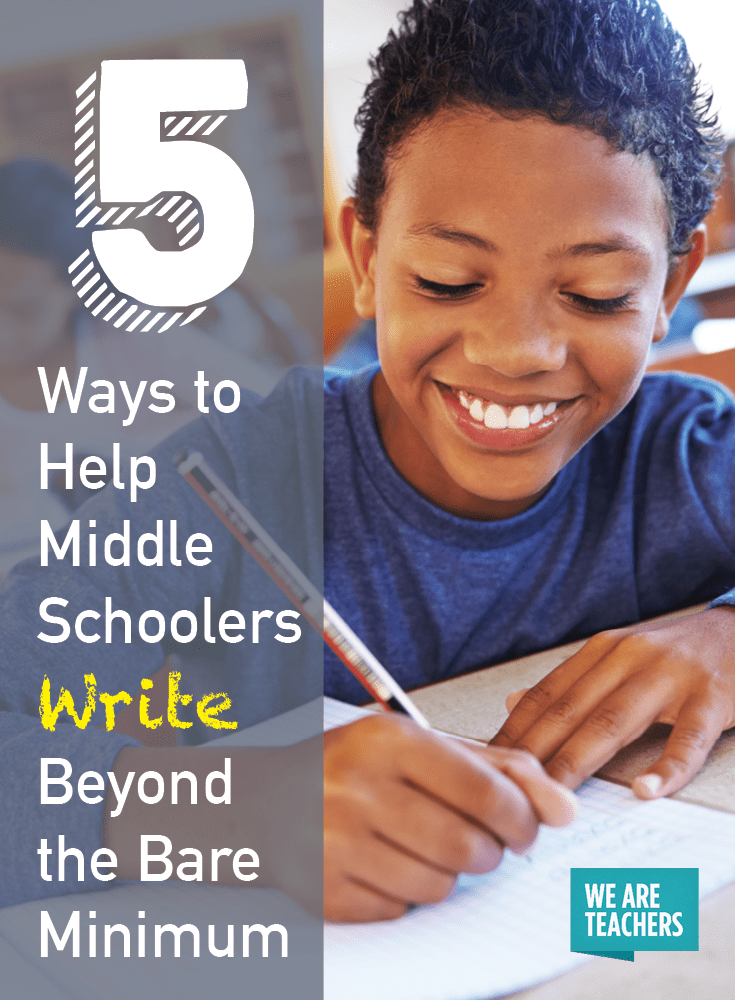
You Might Also Like

Teaching High School English Is the Best Gig Ever. Here’s Why.
IYKYK 📚 Continue Reading
Copyright © 2023. All rights reserved. 5335 Gate Parkway, Jacksonville, FL 32256

5 Tips for Teaching the Writing Process in Middle School ELA

How to Teach Argument Writing Step-By-Step

No doubt, teaching argument writing to middle school students can be tricky. Even the word “argumentative” is off-putting, bringing to mind pointless bickering. But once I came up with argument writing lessons that were both fun and effective, I quickly saw the value in it. And so did my students.
You see, we teachers have an ace up our sleeve. It’s a known fact that from ages 11-14, kids love nothing more than to fire up a good ole battle royale with just about anybody within spitting distance.
Yup. So we’re going to use their powers of contradiction to OUR advantage by showing them how to use our argument writing lessons to power up their real-life persuasion skills. Your students will be knocking each other over in the hall to get to the room first!
I usually plan on taking about three weeks on the entire argument writing workshop. However, there are years when I’ve had to cut it down to two, and that works fine too.
Here are the step-by-step lessons I use to teach argument writing. It might be helpful to teachers who are new to teaching the argument, or to teachers who want to get back to the basics. If it seems formulaic, that’s because it is. In my experience, that’s the best way to get middle school students started.
Prior to Starting the Writer’s Workshop
A couple of weeks prior to starting your unit, assign some quick-write journal topics. I pick one current event topic a day, and I ask students to express their opinion about the topic.
Quick-writes get the kids thinking about what is going on in the world and makes choosing a topic easier later on.
Define Argumentative Writing
I’ll never forget the feeling of panic I had in 7th grade when my teacher told us to start writing an expository essay on snowstorms. How could I write an expository essay if I don’t even know what expository MEANS, I whined to my middle school self.
We can’t assume our students know or remember what argumentative writing is, even if we think they should know. So we have to tell them. Also, define claim and issue while you’re at it.
Establish Purpose
I always tell my students that learning to write an effective argument is key to learning critical thinking skills and is an important part of school AND real-life writing.
We start with a fictional scenario every kid in the history of kids can relate to.
ISSUE : a kid wants to stay up late to go to a party vs. AUDIENCE : the strict mom who likes to say no.
The “party” kid writes his mom a letter that starts with a thesis and a claim: I should be permitted to stay out late to attend the part for several reasons.
By going through this totally relatable scenario using a modified argumentative framework, I’m able to demonstrate the difference between persuasion and argument, the importance of data and factual evidence, and the value of a counterclaim and rebuttal.
Students love to debate whether or not strict mom should allow party kid to attend the party. More importantly, it’s a great way to introduce the art of the argument, because kids can see how they can use the skills to their personal advantage.
Persuasive Writing Differs From Argument Writing
At the middle school level, students need to understand persuasive and argument writing in a concrete way. Therefore, I keep it simple by explaining that both types of writing involve a claim. However, in persuasive writing, the supporting details are based on opinions, feelings, and emotions, while in argument writing the supporting details are based on researching factual evidence.
I give kids a few examples to see if they can tell the difference between argumentation and persuasion before we move on.
Argumentative Essay Terminology
In order to write a complete argumentative essay, students need to be familiar with some key terminology . Some teachers name the parts differently, so I try to give them more than one word if necessary:
- thesis statement
- bridge/warrant
- counterclaim/counterargument*
- turn-back/refutation
*If you follow Common Core Standards, the counterargument is not required for 6th-grade argument writing. All of the teachers in my school teach it anyway, and I’m thankful for that when the kids get to 7th grade.
Organizing the Argumentative Essay
I teach students how to write a step-by-step 5 paragraph argumentative essay consisting of the following:
- Introduction : Includes a lead/hook, background information about the topic, and a thesis statement that includes the claim.
- Body Paragraph #1 : Introduces the first reason that the claim is valid. Supports that reason with facts, examples, and/or data.
- Body Paragraph #2 : The second reason the claim is valid. Supporting evidence as above.
- Counterargument (Body Paragraph #3): Introduction of an opposing claim, then includes a turn-back to take the reader back to the original claim.
- Conclusion : Restates the thesis statement, summarizes the main idea, and contains a strong concluding statement that might be a call to action.
Mentor Texts
If we want students to write a certain way, we should provide high-quality mentor texts that are exact models of what we expect them to write.
I know a lot of teachers will use picture books or editorials that present arguments for this, and I can get behind that. But only if specific exemplary essays are also used, and this is why.
If I want to learn Italian cooking, I’m not going to just watch the Romanos enjoy a holiday feast on Everybody Loves Raymond . I need to slow it down and follow every little step my girl Lidia Bastianich makes.
The same goes for teaching argument writing. If we want students to write 5 paragraph essays, that’s what we should show them.
In fact, don’t just display those mentor texts like a museum piece. Dissect the heck out of those essays. Pull them apart like a Thanksgiving turkey. Disassemble the essay sentence by sentence and have the kids label the parts and reassemble them. This is how they will learn how to structure their own writing.
Also, encourage your detectives to evaluate the evidence. Ask students to make note of how the authors use anecdotes, statistics, and facts. Have them evaluate the evidence and whether or not the writer fully analyzes it and connects it to the claim.
This is absolutely the best way for kids to understand the purpose of each part of the essay.
Research Time
Most of my students are not very experienced with performing research when we do this unit, so I ease them into it. (Our “big” research unit comes later in the year with our feature article unit .)
I start them off by showing this short video on how to find reliable sources. We use data collection sheets and our school library’s database for research. There are also some awesome, kid-friendly research sites listed on the Ask a Tech Teacher Blog .
Step-By-Step Drafting
The bedrock of drafting is to start with a solid graphic organizer. I have to differentiate for my writers, and I’ve found they have the most success when I offer three types of graphic organizers.
1- Least Support: This is your standard graphic organizer. It labels each paragraph and has a dedicated section for each part of the paragraph.
2- Moderate Support: This one has labels and sections, but also includes sentence stems for each sentence in the paragraph.
3- Most Support: This one has labels and sections and also includes fill-in-the-blank sentence frames . It’s perfect for my emerging writers, and as I’ve mentioned previously, students do NOT need the frames for long and soon become competent and independent writers.
Writing the Introduction
The introduction has three parts and purposes.
First, it has a hook or lead. While it should be about the topic, it shouldn’t state the writer’s position on the topic. I encourage students to start with a quote by a famous person, an unusual detail, a statistic, or a fact.
Kids will often try to start with a question, but I discourage that unless their question also includes one of the other strategies. Otherwise, I end up with 100 essays that start with, “Do you like sharks?” Lol
Next, it’s time to introduce the issue. This is the background information that readers need in order to understand the controversy.
Last, students should state the claim in the thesis statement. I call it a promise to the reader that the essay will deliver by proving that the claim is valid.
Writing the Supporting Body Paragraphs
Each supporting body paragraph should start with a topic sentence that introduces the idea and states the reason why the claim is valid. The following sentences in the paragraph should support that reason with facts, examples, data, or expert opinions. The bridge is the sentence that connects that piece of evidence to the argument’s claim. The concluding sentence should restate the reason.
Writing the Counterclaim Paragraph
The counterclaim paragraph is a very important aspect of argument writing. It’s where we introduce an opposing argument and then confidently take the reader back to the original argument. I tell students that it’s necessary to “get in the head” of the person who might not agree with their claim, by predicting their objections.
It can be tough for kids to “flip the switch” on their own argument, so I like to practice this a bit. I give them several pairs of transitions that go together to form a counterclaim and rebuttal. I also switch up what I call this part so that they use the terminology interchangeably.
- It might seem that [ counterargument . ]However, [ turn-back .]
- Opponents may argue that [ counterargument .] Nevertheless, [ turn back .]
- A common argument against this position is [ counterargument .] Yet, [ turn-back .]
A great way for kids to practice this is to have them work with partners to write a few counterarguments together. I let them practice by giving them easy role-playing topics.
- Your cousins want to jump into a poison ivy grove for a TikTok challenge. Choose your position on this and write a counterargument and turn-back.
- Your friend wants to get a full-face tattoo of their boyfriend’s name. Choose your position on this and write a counterargument and turn-back.
This kind of practice makes the counterargument much more clear.
The concluding paragraph should remind the reader of what was argued in the essay and why it matters. It might also suggest solutions or further research that could be done on the topic. Or students can write a call to action that asks the reader to perform an action in regard to the information they’ve just learned.
My students write about local issues and then turn the essays into letters to our superintendent, school board, or state senators. It’s an amazing way to empower kids and to show them that their opinion matters. I’ve written about that here and I’ve included the sentence frames for the letters in my argumentative writing unit.
I hope this gives you a good overview of teaching argument writing. Please leave any questions below. Please also share your ideas, because we all need all the help we can give each other!
And one more thing. Don’t be surprised if parents start asking you to tone down the unit because it’s become harder to tell their kids why they can’t stay up late for parties. 🙂
Stay delicious!

Narrative Writing Workshop for Middle School ELA

Fiction & Nonfiction Reading -Teach, Practice, Test BUNDLE – Middle School ELA

RACES Writing Introduction to Paragraph Frames DIGITAL & EDITABLE
MAKE WAVES WITH THIS FREE WEEKLONG VOCABULARY UNIT!

10 Steps to Teach Persuasive Writing
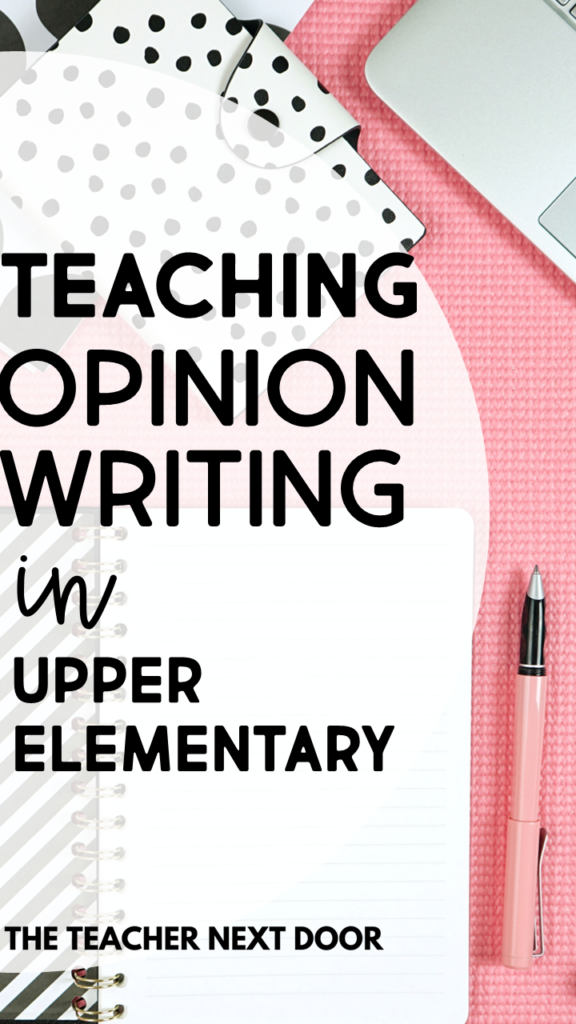
Kids are natural-born persuaders. They do it all the time. The trick as a teacher is to take their set of skills and help them use their power for good. And by good, I mean to channel these skills into writing effective persuasive pieces.
So, what exactly do we need to do to teach persuasive writing? I won’t lie to you…it’s not an easy task, but I’ll try to break it down here and simplify the steps to hopefully make this something that you can use in your classroom.
1. Teach Paragraph Writing FIRST
Before I even begin to think about teaching students to create an opinion piece, I make sure that my class has learned the basics of writing a good paragraph. We spend a lot of time with each component, and after they’ve mastered one paragraph, we move on to the five-paragraph essay.
Since I teach 4th/5th, this is one of the standards we need to reach. Once I know that students can write a reasonably good essay, then they can learn an opinion essay a little more easily.
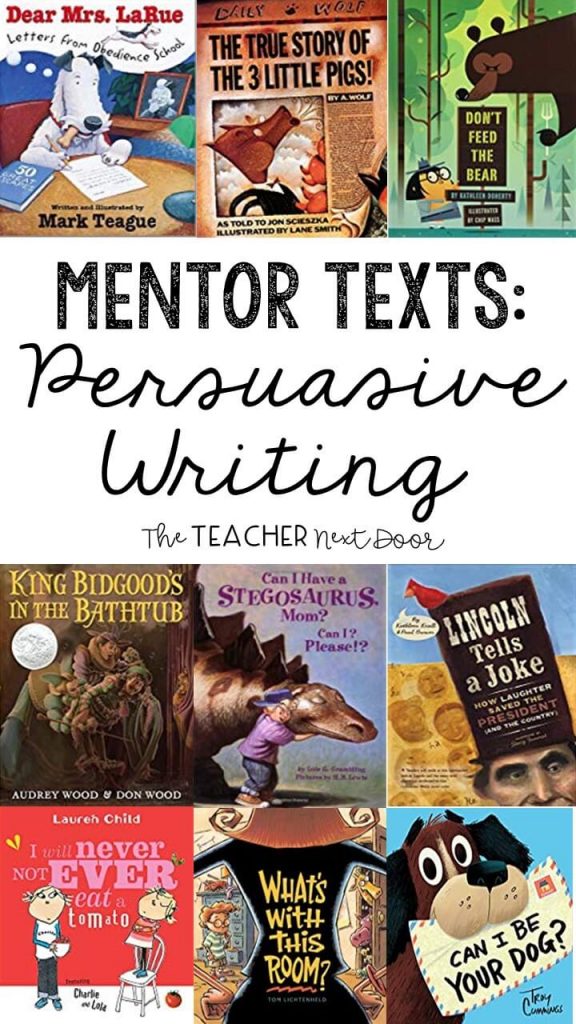

2. Use Mentor Texts to Introduce Opinion Writing
I am a big fan of mentor texts. I just love how picture books easily capture the attention of my “big” kids, while quickly teaching them so many lessons.
When I teach opinion writing, I like to gather several of these persuasive mentor texts and share them with my class. We talk about how the character used persuasive techniques well, or how he/she didn’t.
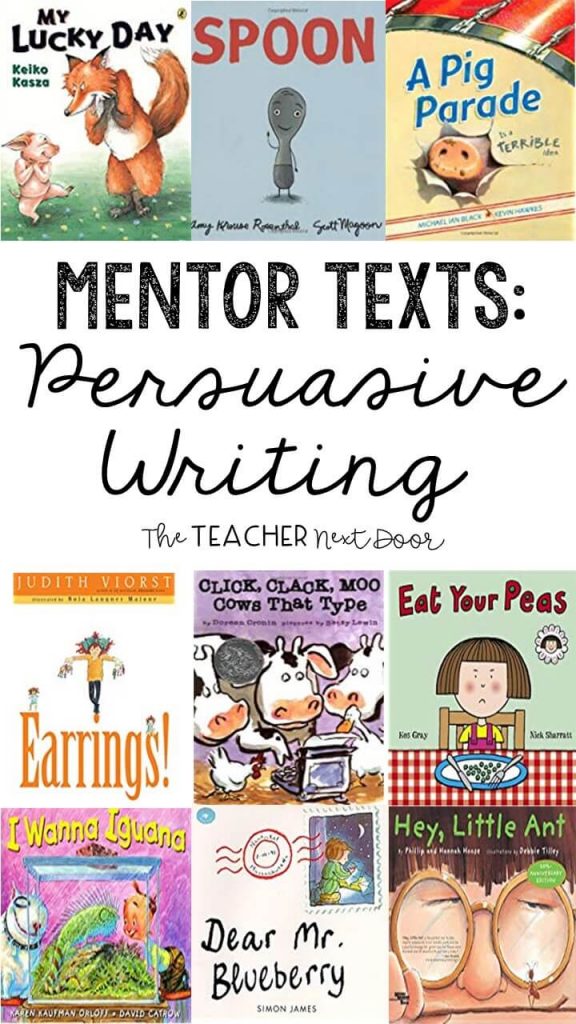
3. Start With the Big Picture
Before we start to officially write, we talk about what an opinion essay is and isn’t. I like to give students three choices with similar topics and ask them which one is the opinion essay. For example, they might choose between these titles: The Magical Elephant, Elephants and Their Families, and How to Save the Elephants. Next, I have a handout that shows the structure of an opinion essay. Since we’ve written five-paragraph essays before, they have a good handle on the basic essay structure. Then I guide them step by step through each component. We absolutely do not write a single opinion essay until we’ve had the opportunity to have lots of mini-lessons, see many examples, and practice all parts of the essay in a very low-stakes environment.
4. The Introduction Paragraph is First
A. introduce hooks.
Now we spend some time focusing on how to start the essay. We start by using a hook (also called a lead).
I like to describe a writing “hook” using a fishing analogy. The fisherman puts a nice pink, juicy worm on the hook, hoping to attract the attention of the fish. If the fish bites, the fisherman’s happy. If the fish doesn’t bite, that means that it wasn’t interested in the hook, and there won’t be any fish caught.
Our goal as a writer is to get the reader interested by “hooking” them into reading our essay, from the very first sentence.
We go over six different types of hooks and practice these. I also love using opinion writing posters as I introduce each new opinion essay concept. They’re a great reference for students on the wall or printed in miniature for writing notebooks.
B. Review Topic Sentences
For an opinion essay, the topic sentence is the opinion sentence. It is the author’s viewpoint. We do a lesson reviewing the five types of topic sentences we use for paragraph and essay writing, and I show students how to tweak these into opinion statements.
C. Time to Add the Three Reasons
The last part of the introduction lists the three reasons for our opinion. I teach students that these can be listed as a single sentence with commas between them, or we can write three separate sentences, one for each reason.
For the first lesson on reasons, I give students a topic (cell phones or vending machines at school or which season is the best, etc.) and then ask students to write three bullet points on their whiteboards. Next to each one, they write a word to describe a reason they like/dislike this idea.
For example, if the topic was school uniforms, the child might write lack of individuality, gets boring, uncomfortable… I can quickly glance at their lists while we discuss a few of them, and then we’re ready to practice with the next topic.
Without writing a whole essay, this is teaching students to think about organization and how reasons help support their opinions. I think this kind of practice is great!
When we transition this activity to a full essay, these reasons would turn into the topic sentences for each body paragraph of a five-paragraph opinion essay!
Btw.. if you don’t have whiteboards for your class, this is something you’ll really want to consider. They’re great for writing practice and so many things. I actually purchased shower boards at Home Depot for about $15 to make into whiteboards. They cut them into 12 x 12-inch squares for me for free!
5. Review, Review, Review
After we spend some time on each main section of the opinion essay (the introduction, the body paragraphs, and the conclusion), I like to give my students activities to really reinforce what they’ve learned. Besides review worksheets, we do games (like Stump the Expert), sorts, and color coding.
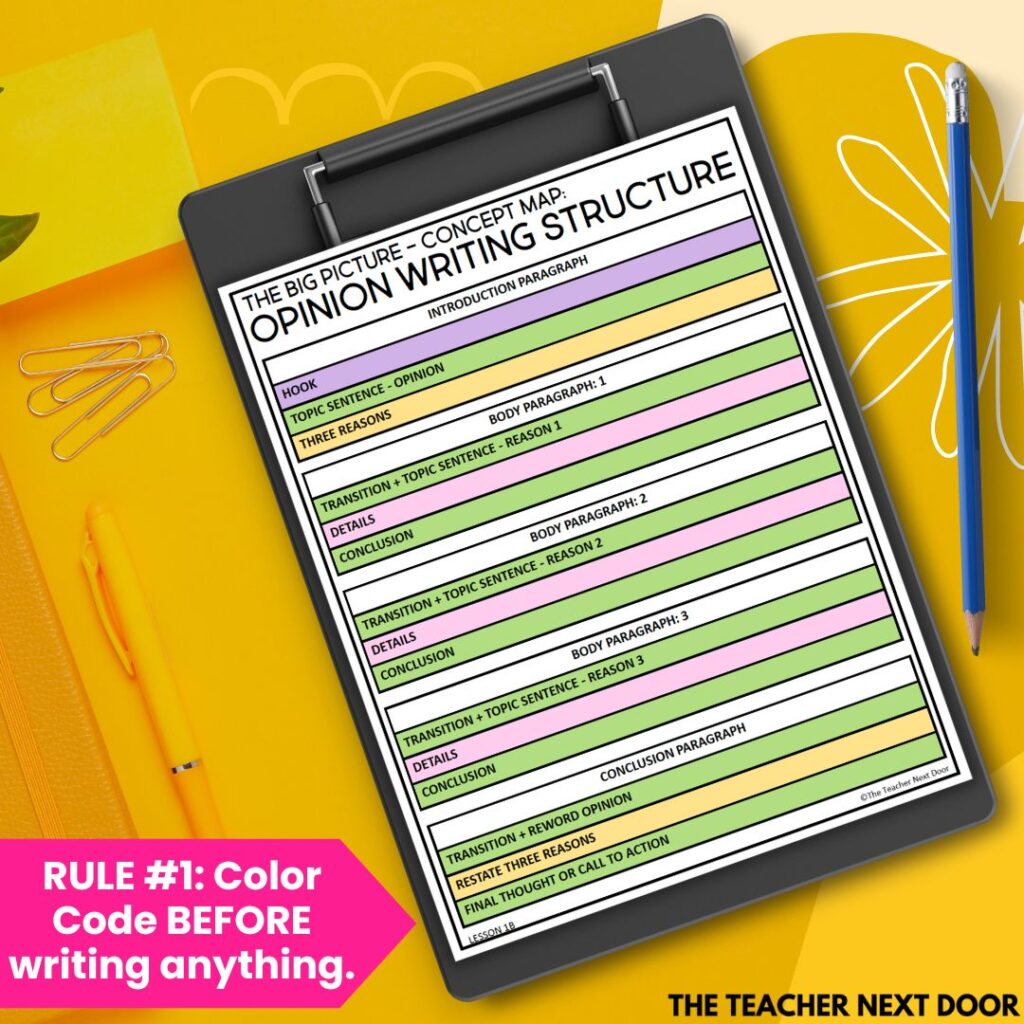
I really like to have students color code already-made paragraphs so they can see examples of quality writing, and they can master the structure of the paragraph . Once we’ve reviewed the introduction, it’s time to move on to the body paragraphs.
6. The Three Body Paragraphs are Next
There are three parts of each body paragraph, and I teach each part separately, one by one. The parts include a topic sentence that starts with a transition, three to five details to describe and explain the author’s reason for his/her viewpoint, and a conclusion sentence.
These three paragraphs are the meat of the essay. This is where students explain why they support or don’t support something.
We spend time doing activities like looking at three sentences and identifying which one is the topic sentence, which one is a detail, and which one is a conclusion sentence.
We look at pre-made topic sentences and related conclusion sentences and rate them as part of a great class discussion and then in pairs or independently. Then, we review with more color coding, games, and sorts.
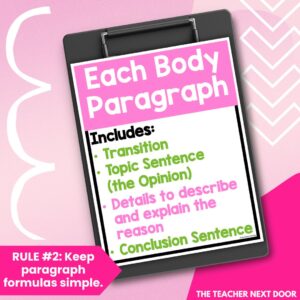
7. Focus on the Conclusion Paragraph
Conclusions can be a little intimidating for some students. Maybe it’s because they’re tired from the heavy lifting of the other four paragraphs, but with practice, you can help take away some of their apprehension and replace it with confidence!
The conclusion paragraph is a shorter paragraph (in 3rd – 5th grade) than a body paragraph. It has three distinct parts, an opinion sentence that starts with a transition, the three reasons, and a final thought or call to action.
A. The Opinion Sentence Starting with a Transition
The opinion sentence is really a topic sentence. It reinforces the same idea presented in the introduction paragraph but uses synonyms and usually a different type of topic sentence than the introduction to add variety.
We go over specific transitions that can be used for conclusions. While students may not always use a transition for their conclusion later on, I think it gives students structure and helps them break the ice of crafting a strong conclusion paragraph.
B. The Three Reasons (again!)
Just like the introduction paragraph, the conclusion paragraph lists the three reasons, usually in a single sentence with commas. Like always, you’ll want students to reword the sentence using synonyms to add variety.
C. The Conclusion, The Ending, The VERY LAST SENTENCE!
This last sentence is another place students may feel apprehensive to write at first. We go over the difference between a final thought and a call to action and practice by seeing lots of exemplars and then creating our own.
By the time we’re finished, most students understand how to gracefully and effectively add the conclusion sentence to finish the opinion essay.
Just like we usually do, once we finish a section, we review that section carefully using handouts, sorts, color coding, games, and reviews.
8. Share an Opinion Essay Example
It’s one thing to talk about an opinion essay’s components and to even practice them. It’s another thing to see a really good example of an essay and to get to go through it and discuss what makes it work and why.
I have several great examples I’ve saved over the years (and I have two that I wrote and included in my opinion essay unit). We take time to color code the essay and then create a reverse outline for it. They save this essay as an example.
9. Make an Outline and an Essay as a Whole Class (Eeek!)
Okay, here’s where your perseverance has to kick in.
Trying to complete an essay as a whole class will drive even the most saintly of teachers to want to pull their hair out at times, but this hard part is crucial. There, I said it. It is that important that this is a step you shouldn’t miss.
Here’s how I do it. I break it down into two to four days. On the first day, we created an outline together. I have students write this outline in their Writer’s Notebooks as a model to refer to when they need to make their own outline later.
We always do school uniforms, because I find it to be a great topic and one that my students feel strongly about.
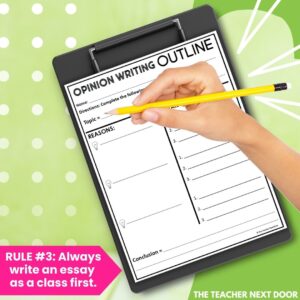
I tell them for the sake of continuity, we need to take a stand as a class for the essay, whether they really agree with that stand or not. We take a class vote and then stick with it, whether it’s for or against the uniform idea.
On the second day, when we have the outline in place, I make a deal with the kids…I tell them if they stick with me, stay on task, and participate…I’ll do the writing (this time), and they can just tell me what to write.
If they don’t stay focused, then they’ll have to write it themselves. This works like magic. I’ve never had a class that lost out on this “deal.”
So, using yesterday’s outline, we go step by step and write each paragraph together. Students feed me sentences (I write these on the SmartBoard), which I try to use or gently guide them a bit where needed.
Usually, we do about 2 paragraphs in one day. The attention spans of 8 – 11-year-olds can be a killer, so I find that breaking it into several days helps.
10. Before Students Write – Go over Expectations Using a Rubric
I really like to use rubrics for lots of assignments. It breaks down the activity into its components, and it also serves as a road map for students to know what is expected of them. I think the more we can explain to students exactly what we’re looking for, the more they can meet and sometimes exceed (hallelujah) our expectations.
There’s never a reason to hide what we want from students, in my opinion. So, we go over the rubric together, and it’s a kind of review for all the lessons leading up to this. You can three-hole punch it so they can store it in their binders, or you can print it in a smaller size to fit their Writer’s Notebooks if you wish.
BONUS #11. Practice Writing Opinion Essays…Over and Over and…
Once your students have practiced each part of the opinion essay and are very familiar with its structure, it’s their turn to write independently. I choose several different topics for them over the next few weeks, and we do about an essay a week in class. The students get better as time goes by, and usually, I let them choose a topic for the last essay or two. It’s interesting to see what they come up with.
Whew…such a huge unit and so many skills to fit in, but in my mind, it is an awesome unit. I love teaching it because of the great number of discussions it provides and because I see it as an important set of tools for them to have in their writing toolboxes.

If you’d like some resources for opinion writing , I love this unit I created. It’s a bundle with over 100 printable pages and includes a digital format too. It will take you through the entire process with teaching pages, and detailed teaching notes, student practice pages, activities, and posters for 3rd – 5th grade.
Sarah is a 4th Grade Teacher and uses this unit and process in her classroom. This is what she had to say.

CLICK HERE TO FIND THE OPINION WRITING BUNDLE ON TPT!

- Read more about: Writing & Grammar
You might also like...
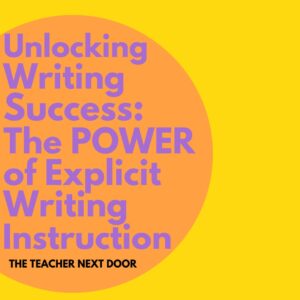
Unlocking Student Writing Success: The Power of Explicit Writing Instruction
As upper elementary teachers, our goal is to create strong writers. However, the lack of Explicit Writing Instruction has caused students in the US to
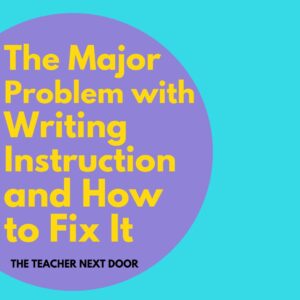
The Major Problem with Writing Instruction and How to Fix It
Writing instruction at the elementary level needs an overhaul. The last time the National Assessment of Education Progress (NAEP) measured 8th-grade students’ writing proficiency in
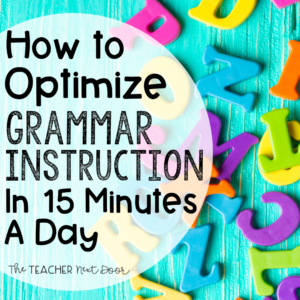
How to Optimize Grammar Instruction in 15 Minutes a Day
As elementary school teachers, we are always thinking about how to integrate subjects. History content and nonfiction text features. A science equation and a math
Hi, I’m Jenn, CEO and owner of The Teacher Next Door!
I know that you strive to be an effective upper elementary teacher while maintaining a healthy work-life balance.
In order to do that, you need resources that are impactful, yet simple .
The problem is that most resources and curriculums out there are far from simple. The pages upon pages of daily lesson plans are just plain overwhelming .
At TTND, we believe teachers should be living their lives outside of the classroom, and not spend hours lesson planning and searching for resources.
We understand that now, more than ever, teachers need space to be themselves which is why we create and support teachers with timesaving tips and standards-aligned resources.
Want access to TTND's Free Resource Library? Sign up for our newsletter and we'll email you the exclusive password!
Trending posts.

SEARCH BY TOPIC
- Classroom Ideas
- Holidays and Seasonal
- Mentor Texts
- Reading Block
- Uncategorized
- Writing & Grammar
POPULAR RESOURCES

Facebook Group
Teachers Pay Teachers
Free Resource Library
💌 Contact Us
Disclosures
Privacy Policy
Refund Policy
Purchase Orders
Your Downloads
Reward Points
© The Teacher Next Door, LLC. All rights reserved.

* Please note: If your school has strong email filters, you may wish to use your personal email to ensure access.
Just added to your cart
The Art of Teaching Essay Writing to Middle and High School Students
Are you a middle or high school teacher tasked with teaching essay writing to your students, do you want to ensure that your students become confident and proficient writers.
We have compiled some answers to the most commonly asked questions about teaching essay writing to middle and high school students.
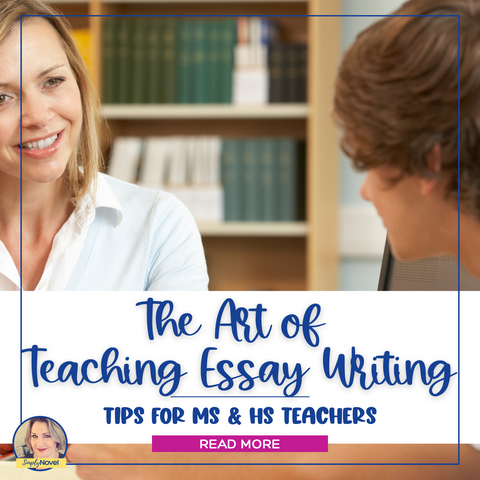
What are the essential components of an essay, and how can I effectively teach them to students?
The essential components of an essay include an introduction, body paragraphs, and a conclusion. To teach these components effectively, break them down into smaller sections and provide examples of well-written essays. Teach students how to structure their essays by creating an outline before writing the first draft. For teaching basic essay components, check out our Essay Writing Basics Bundle
How can I help students develop and organize their ideas and arguments effectively?
To help students develop and organize their ideas and arguments effectively, start by teaching them how to brainstorm and create a mind map. Encourage them to group their ideas into categories and teach them how to order their thoughts logically. Also, show them how to use transitions to link their ideas and ensure a smooth flow throughout the essay.
How can I teach students to write clear and concise thesis statements that accurately reflect the main argument of their essay?
Teaching students how to write a clear and concise thesis statement is essential. Show them examples of good and bad thesis statements and teach them how to use precise language to convey their argument. Encourage them to avoid vague or general statements and ensure that their thesis statement is specific and relevant to their essay topic.
How can I encourage students to use evidence and examples to support their claims?
Encourage students to use evidence and examples to support their claims by teaching them how to research and gather information from reliable sources. Teach them how to analyze and evaluate their sources to determine their credibility. Encourage them to use quotes and statistics to support their arguments and ensure that they cite their sources properly.
How can I teach students to write effective introductions and conclusions?
Teaching students how to write effective introductions and conclusions is crucial. Encourage them to start their essay with a hook, such as a quote, anecdote, or a rhetorical question. Teach them how to write a clear thesis statement and preview the main points they will be discussing in their essay. For the conclusion, teach them to restate the thesis statement and summarize the main points of their essay.
How can I help students understand the importance of editing and revising their work?
Teach students to understand the importance of editing and revising their work by showing them examples of poorly written essays and the impact of careless mistakes. Encourage them to take breaks between writing and revising to help them see their work from a fresh perspective. Teach them how to proofread their work for grammar, punctuation, and spelling errors.
How can I provide feedback that is both constructive and helpful to students?
Provide feedback that is both constructive and helpful to students by focusing on specific areas that need improvement. Avoid criticism and instead provide suggestions for improvement. Use positive language and encourage students to take risks and experiment with their writing.
How can I differentiate instruction to meet the needs of students with different learning styles and abilities?
Differentiate instruction to meet the needs of students with different learning styles and abilities by using a variety of teaching methods. Incorporate visual aids, group work, and hands-on activities to engage students with different learning styles. Provide extra support and resources for students who need additional help.
How can I help students develop their own voice and style in their writing?
Help students develop their own voice and style in their writing by encouraging them to write about topics they are passionate about. Teach them to write in their own voice, using a tone that reflects their personality. Encourage them to experiment with different writing styles and techniques to help them find their own unique style.
How can I create assignments and assessments that accurately measure students' understanding of essay writing concepts and skills?
To create assignments and assessments that accurately measure students' understanding of essay writing concepts and skills, create rubrics that clearly define the expectations for the assignment. Provide students with clear instructions and expectations for the assignment. Assess their essays based on the essential components of an essay, including the thesis statement, evidence, organization, and writing style.
Teaching essay writing to middle and high school students can be a challenging task, but with the right strategies and techniques, you can help your students become confident and proficient writers.
By breaking down the essential components of an essay, teaching students how to develop and organize their ideas, and providing feedback that is both constructive and helpful, you can help your students master the art of essay writing.
- Share Share on Facebook
- Tweet Tweet on Twitter
- Pin it Pin on Pinterest
Leave a comment
Please note, comments must be approved before they are published
- choosing a selection results in a full page refresh
- press the space key then arrow keys to make a selection

Bell Ringers
Teaching argumentative writing in middle school ela: part one.
If you teach middle school, you know that teenagers have a lot of opinions! Luckily, you can use that to your advantage when teaching students how to write an argumentative essay. The key is to help students learn to craft well-written arguments with evidence (not just arguing for the sake of it, which middle schoolers can be prone to).
While learning to craft argumentative essays will help students in school, being able to craft and defend an argument is also an important skill for the real world. Writing an argumentative essay or having a debate requires critical thinking skills and the ability to take a stance and back it up.
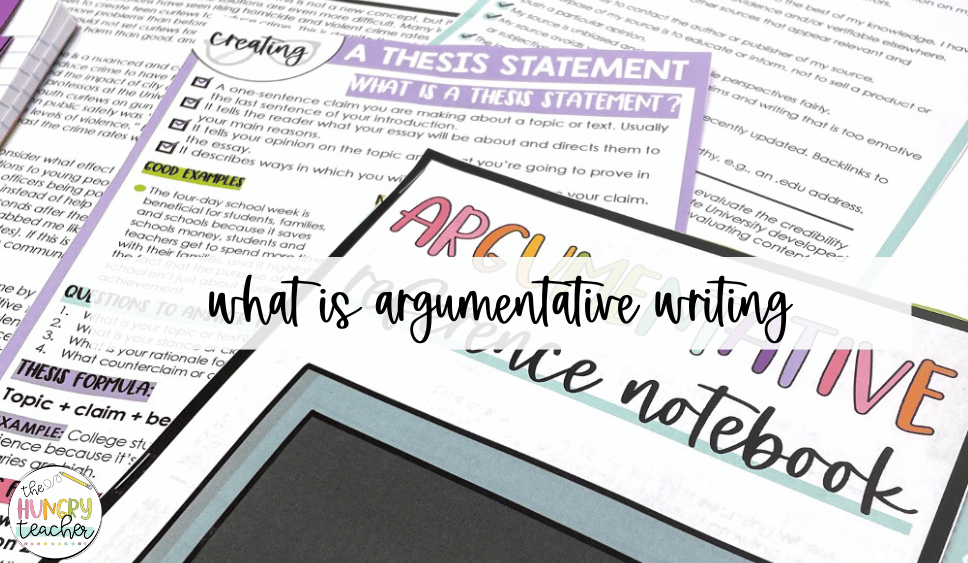
What is Argumentative Writing?
In order for students to understand how to write an argumentative essay, they need to understand what argumentative writing is.
Argumentative essays usually require that students do some investigation or research on a topic and then choose a clear stance. When writing, students will spend the body of the essay explaining points and providing evidence that supports their stance. A counterargument is also typically given as a way to counteract how “nay-sayers” would disagree with the writer. At the end of the essay, students will restate their argument and summarize their evidence.
How to Introduce Argumentative Writing: The Debate
Now that we know what to expect from argumentative writing, we can get into how to write an argumentative essay. You’ll want to start by introducing argumentative writing, which I liked to do through debates. Just like in an essay, to successfully debate a topic, students must do some investigation, choose a stance, and then argue their point in a meaningful way. Holding a class debate is a great place to start when introducing argumentative writing. Debating a topic verbally can actually be used as a brainstorming session before students ever even put pen to paper. For students new to argumentative writing, this takes some of the pressure off of jumping right into the writing process and helps them generate ideas.
There are a few ways you can use debates. For instance, you can choose a topic you’d like students to debate or let them choose a topic they’re already passionate about.
I liked to give students a few minutes to think through the topic and prep on their own, and then I partner them up. They can either debate the topic with their partner, or they can work together with their partner to debate another pair.
Depending on your class size, you could also split the class in half and make it a whole group debate. As long as students are researching or investigating in some way, choosing a stance, and finding reasons to back up their position, there is no wrong way to hold a debate in your class – and you can try out a few different formats to see what works best.
After the debates, it’s a great idea to debrief. This is a good time to bring in some key vocabulary and reinforce how to write an argumentative essay. For example, you can look over some of the evidence presented and ask students to rate the “strength” of the argument. You can also brainstorm a counterargument together.
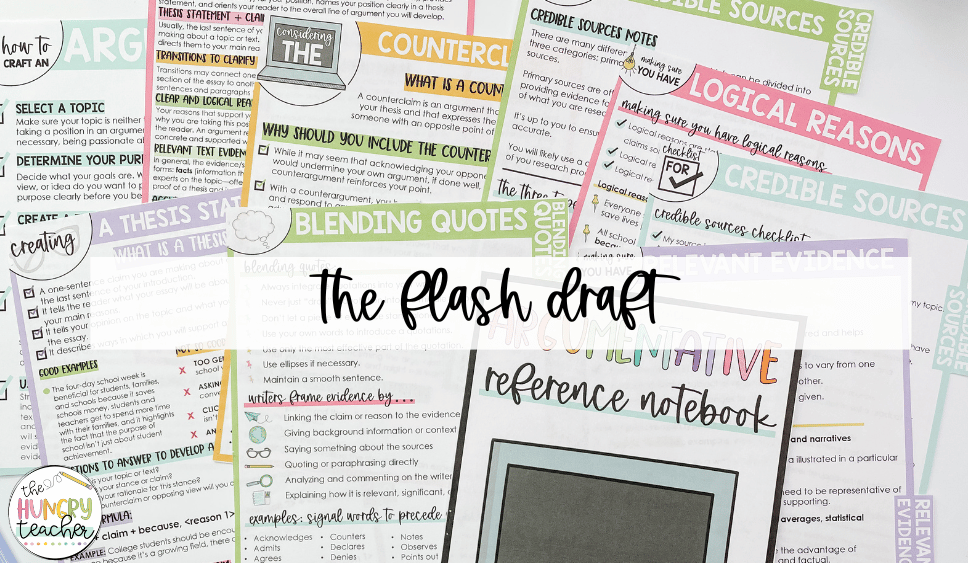
How to Introduce Argumentative Writing: The Flash Draft
After students debate, they move on to the flash draft. A flash draft is essentially a giant brain dump. Students do not have to worry about spelling, grammar, organization, or even structure. They will simply be taking their thoughts from the debate and getting them down on paper.
One benefit to the flash draft is it removes the barrier of intimidation for a lot of students. For many kids, the actual work of starting to write can be daunting. A flash draft removes that intimidation of perfection and just requires something to be on the page. Again, the flash draft portion can be completely tailored to best suit your students and classroom. You can set a timer for a specific amount of time, you can provide students with an outline or guiding questions, or you can give them sentence stems to start.
If you have access to technology in your classroom, you can even let students verbalize their flash draft and use transcription technology to get it on paper.
Expanding Knowledge of Argumentative Writing
By now, you might be wondering when you’ll actually dive deeper into how to write an argumentative essay. That will start with a mini-lesson. These mini-lessons should cover the key parts of argumentative essays, like how to take a stance, ways to support your position, how to transition between thoughts, and even how to craft a counterargument.
You could have a mini-lesson before each flash draft to focus on a particular skill, or you can hold the mini-lesson after the flash draft and let students focus on that skill during revisions. During mini-lessons, I highly suggest using mentor texts, guided examples, or other reference materials. When it comes to writing, many students need to see the process in action, so modeling and having a place for them to reference will be super key to their success.
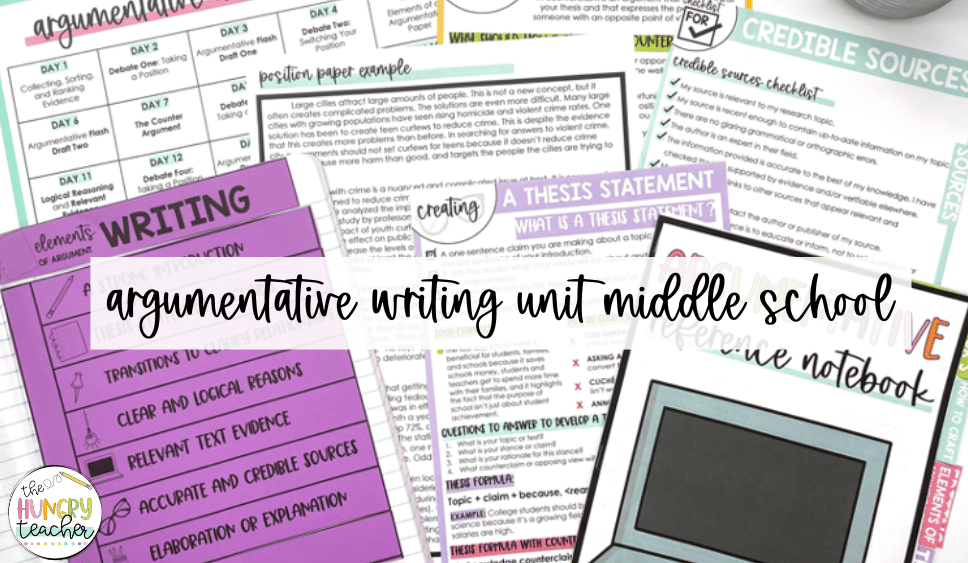
Argumentative Writing Unit for Middle School
Want support putting together your argumentative essay unit? My done-for-you Argumentative Writing Unit scaffolds how to write an argumentative essay for you and your students.
The unit includes 23 full lesson plans, slide presentations, notebook pages for students, teacher keys and examples, student references pages, and more for a well-rounded unit.
Plus, this unit goes through the exact process I talked about in the blog, using debate, flash drafts, and mini-lessons to scaffold students through the writing process.

- Read more about: Middle School Writing
You might also like...
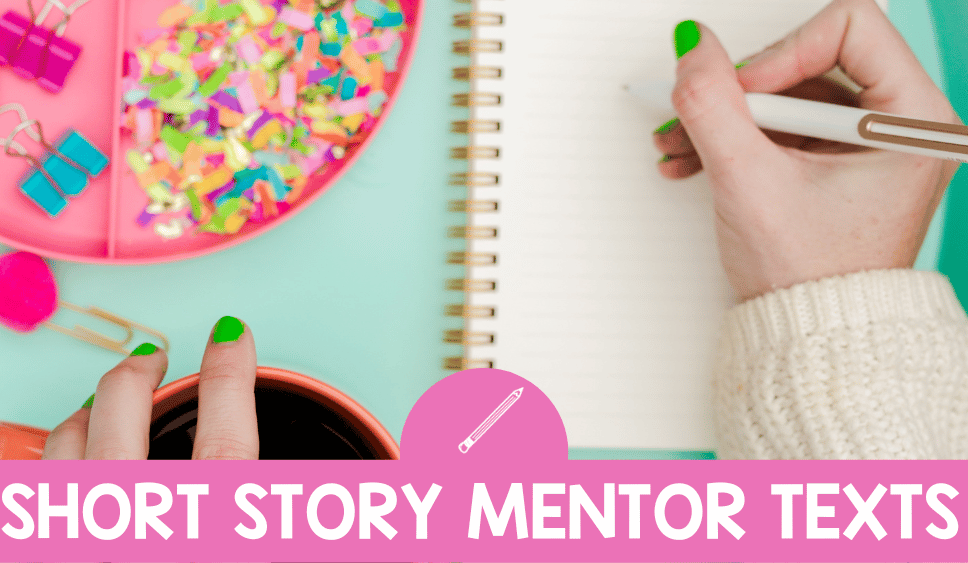
Short Story Mentor Texts to Teach Narrative Writing Elements

Using Mentor Texts for Narrative Writing in Middle School ELA
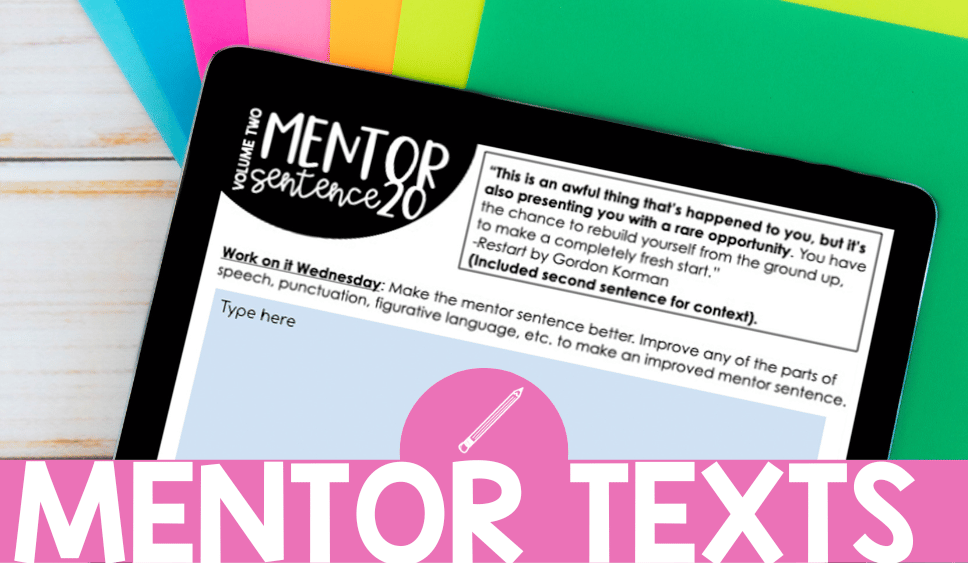
Mentor Texts: When and How To Use Them in Your ELA Lessons
Get your free middle school ela pacing guides with completed scopes and sequences for the school year..

My ELA scope and sequence guides break down every single middle school ELA standard and concept for reading, writing, and language in 6th, 7th, and 8th grade. Use the guides and resources exactly as is or as inspiration for you own!
Meet Martina

I’m a Middle School ELA teacher committed to helping you improve your teaching & implement systems that help you get everything done during the school day!
Let's Connect
Member login.
PRIVACY POLICY
TERMS OF USE
WEBSITE DISCLAIMERS
MEMBERSHIP AGREEEMENT
© The Hungry Teacher • Website by KristenDoyle.co • Contact Martina

How to Teach Essay Writing in Secondary ELA
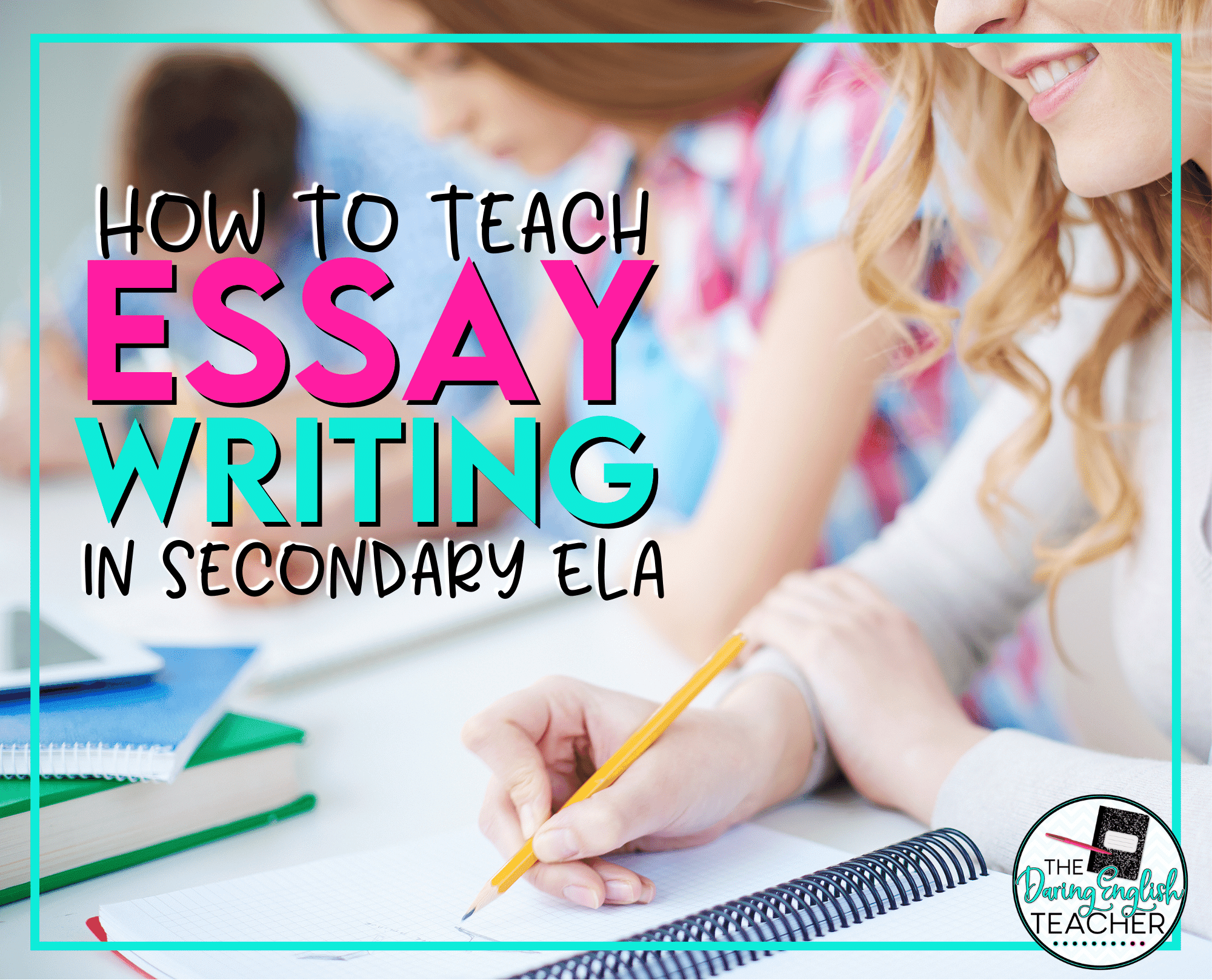
Teaching students how to write a multi-paragraph essay is a process, and it isn’t something that can be taught in one class period, nor is it a skill that we should expect our incoming students to know. Before I even assign my students a multi-paragraph essay, I first take several weeks to teach paragraph writing, and I typically do this with my short story unit.
However, once my students are ready to make the jump from paragraphs to an essay, I still continue to break down my writing instruction. When I teach essay writing in my high school English students, I break it down paragraph-by-paragraph to encourage them to be the best writer they can be. All of the lessons that I will refer to throughout this blog post are included in this print and digital essay writing teaching unit .
Teach Essay Writing in Middle School and High School ELA
Start with brainstorming.
I am a huge fan of group brainstorming, especially since I usually have some EL and SPED students mainstreamed in my college prep English classes. I usually dedicate an entire class period to brainstorming where students gather ideas, paragraph topics, and supporting quotes. You can read more about group brainstorming in this blog post where I discuss brainstorming with my students and I teach them how to brainstorm an essay.
Outline the essay
After brainstorming, I move my students to the outlining phase of the writing process. This step is essential because it helps students organize their papers and stay on topic. Ever since I started dedicating an entire class period to in-class essay outlining, I’ve noticed a significant improvement in my students’ essays. You can read more about how I teach essay outlining in this blog post . When we focus on outlining the essay, I make sure that we focus on all of the essential components of an essay: thesis statement, topic sentences, and evidence.
Write the thesis statement
After the class has completed the brainstorming and outlining, I then move on to direct instruction for essay writing. Since students have already outlined their main ideas, they can start working on their thesis statement. I use my introduction and thesis statement lesson to help students write a meaningful thesis statement. I also look at examples of good thesis statements with my students and have students turn in their draft thesis statements to me before moving on.
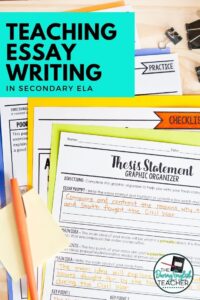
Write the introduction
Once students have a solid working thesis statement (and I say working because it is possible for it to change throughout this process), I then have them move on to the introduction. Using the same introduction and thesis writing lesson, I then have my students work on drafting a hook and background information to complete their introduction. Now that students are in high school, I don’t accept a question as an acceptable hook. However, if my students get stuck, especially some of my lower students, I have them write their questions and then help them turn them into a statement.
Also, I’ve noticed that students sometimes have a hard time jumping on the hook. They tend to get stuck there, and when this happens, I have them jump right into the background information. In doing so, students get started writing, and they can go back to the hook later.
Topic Sentences
When I complete essay outlining with my students before the drafting process, I typically have them outline each paragraph with a topic sentence and then the quotes they want to use. Once we move from the introduction to the body paragraphs, I have them work on their topic sentence first. I use my topic sentences and body paragraphs essay writing lesson with my students at this point in the essay. Once students have a good topic sentence for their body paragraph, they write the rest of their body paragraph.
Write the body paragraphs
The next step in the writing process, especially for the first essay of the school year, is for students to write out the rest of their body paragraphs. If they’ve done their outlining correctly, they have a good idea about what they want to include in their body paragraphs. In this step, I really emphasize that my students need to provide support and analysis. They should be providing more explanation than simply restating their quotes.
Write the conclusion
Once students have their introduction and body paragraphs complete, I then have them move on to writing the conclusion. At this step, I teach conclusion writing to my students and have them restate the thesis and add a general thought to the end of the paragraph. At this point, I emphasize that students should not be adding in any new information. Also, one way to help students rephrase their thesis statement is to have them rewrite it in two sentences since a thesis statement is typically a one-sentence statement.
Complete peer editing
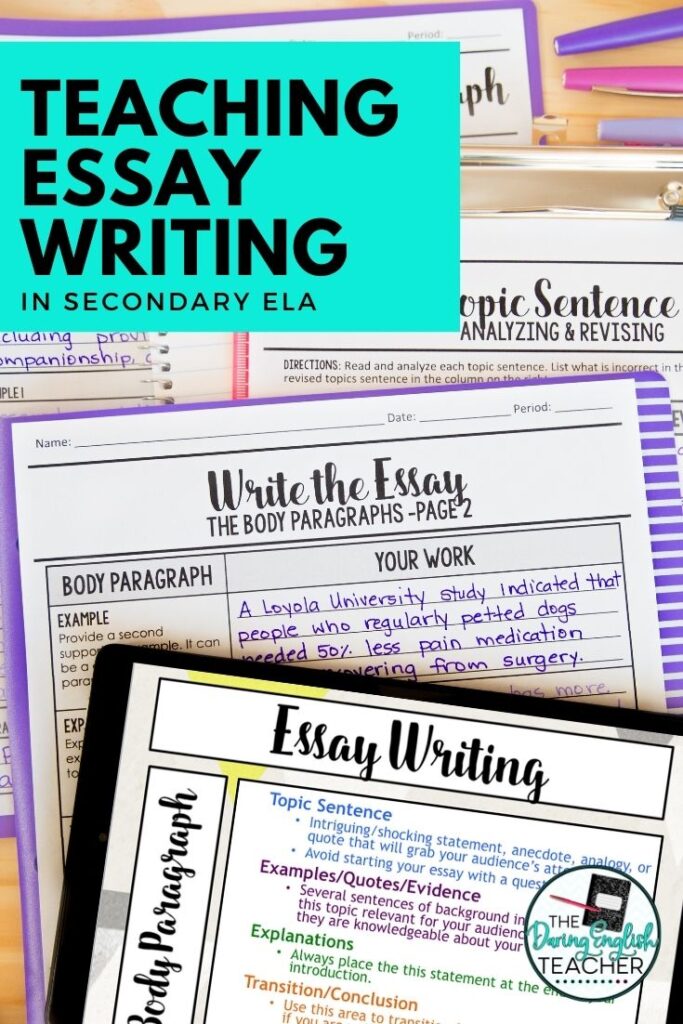
Provide time for essay revisions
Once students revise their essays and turn them in, I still like to provide students with some time to revise their essays after I grade them. This is where true learning and growth happen. It is when a student thinks they are done but then goes back to try to improve their essay. In this blog post about essay revisions , you can read more about how I conduct them in the classroom.
An entire year of writing instruction
What if I told you that you could have all of your writing instruction for the ENTIRE SCHOOL YEAR planned and ready to go? I’m talking about all the major writing strands and peer editing to grading rubrics. Just imagine how much time and stress you’ll save!
It almost sounds too good to be true, right?
It’s not! My Ultimate Writing Bundle is your one-stop shop for all of your writing instruction needs! Plus, your students will thrive with the built-in scaffolding and consistency throughout the year!
Join the Daring English Teacher community!
Subscribe to receive freebies, teaching ideas, and my latest content by email.
I won’t send you spam. Unsubscribe at any time.
Built with ConvertKit
Leave a Reply Cancel reply
Your email address will not be published. Required fields are marked *
Save my name, email, and website in this browser for the next time I comment.

SUBSCRIBE NOW

ChatGPT for Teachers
Trauma-informed practices in schools, teacher well-being, cultivating diversity, equity, & inclusion, integrating technology in the classroom, social-emotional development, covid-19 resources, invest in resilience: summer toolkit, civics & resilience, all toolkits, degree programs, trauma-informed professional development, teacher licensure & certification, how to become - career information, classroom management, instructional design, lifestyle & self-care, online higher ed teaching, current events.

Teaching Language Arts: Resources for Educators
Introduction.
The ability to read and write plays a major role in a student’s ability to succeed in the classroom. It also has enormous implications regarding mental and emotional development, self-esteem, and even health. Highly literate students are more likely to have higher IQs, develop a love for reading, and become sought-after employees as adults.
Those are just a few reasons why a focused language arts curriculum is so vital to a child’s development. Exposure to the concepts of spelling, grammar, storytelling, and composition gives students a basis for how to write and communicate effectively.
Writing Activities
The best writing comes from a place of creativity that is easier to access when assignments are fun and engaging. The resources below include classroom exercises that teach students how to write clearly while also holding their attention.
- Interesting Writing Assignments That Take Students Beyond the Essay : How many five-paragraph essays do students write in their school career? A lot. How many standardized tests require an essay? Most of them. How many…
- Writing into Summer: Creative Assignments Can Keep Students Academically Engaged : Many students see the summer break as a time to put off their studies and stop thinking about school for three months. Yet parents and…
- Share Your Story: Teaching Strategies That Reach Reluctant Writers : In a recent interview in the Stories Teachers Share podcast, high school teacher Alexa Schlechter perfectly described the challenge instructors face with creative writing classes…
- Nerd Culture and Storytelling: How Tabletop Games Can Inspire Creative Writing Students : On Saturday nights, my family sits down and plays a silly game called Munchkin. We go on a quest, establishing our race, class, and armor…
- Examples of Outdoor Activities to Get Your Students Writing : As a teacher, there are only so many things you can do indoors to help your students write. That is why more and more teachers…
- Effectively Teaching Grammar: What Works (and What Doesn’t Work) : All educators agree that students are better writers when they have an understanding of grammar. To be effective writers in school and to effectively communicate…
Teaching Figurative Language
Figurative language is language that is not meant to be taken literally; it deviates from the normal meaning of words and phrases to communicate in a different and more interesting.
Students often use figurative language without even realizing it. Here are the six types of figurative language that students are most likely to come across and use when they’re reading and writing.
- personification
Figurative language allows students to find different and more creative ways to express themselves, both verbally and in writing.
- 11 IDEAS FOR TEACHING FIGURATIVE LANGUAGE MEANINGFULLY
- All Types of Figurative Language
- Summer Workshop Series: Teaching Word Portraiture to Young Writers
Language Arts Lesson Plans Per Grade
The language arts curriculum should be taught according to the developmental stage of students. Younger students (grades 1 to 3) should be taught the building blocks of language. Students in grades 4 to 6 should be expected to start combining concepts and building vocabulary. Middle school students are taught delve into more long-form reading and writing, while high school students should begin putting everything they have learned together.
- 4 Kindergarten Lesson Plans to Help your School’s Language Arts Curriculum
- 4 Tips for Teaching 2nd Grade Writing
- Middle School Level English Language Arts Lesson Plans
- High School Level English Language Arts Lesson Plans
- K-12 Language Arts Classroom Worksheets
Learning Language Arts Through Literature
One of the most effective ways to teach students the building blocks of language is to give them the opportunity to see those building blocks in action.
Literature melds grammar, spelling, figurative language, and many other tenets of the language arts curriculum into a single, cohesive composition. Reading allows students to practice interpreting the meaning of certain words and phrases through context and to develop ideas regarding how to use them in their own work.
- Mixing Fun Into Poetry Lessons Can Engage Students
- English Teachers: How You Can Use STEAM in Your Classroom
- Finding the Right Language Arts Curriculum
- How to Teach Reading Comprehension
- Literature Study Guides (free)
Teaching Essay Writing
Essay writing allows students to apply what they have learned from the language arts curriculum. It gives them practice expressing themselves personally, and it teaches how to conduct effective research to support an argument.
Written communication is critical for success, so the consequences of not writing essays include missing out on the ability to clearly and concisely communicate with the written word.
The below links give inspiration for assigning essays and assignments that help students develop their research abilities.
- Online & Campus Doctorate (EdD) in Administra...
- Early Childhood Education: Resources, Theorie...
- COVID-19 Teacher Toolkit: Resilience Through ...
- Our Mission
Planning Writing Lessons for the Early Elementary Grades
Teachers can provide thoughtful instruction that supports the sustained development of young students’ literacy skills.

Often, attempting to plan effective and purposeful writing instruction raises many questions: What does lesson planning look like? How will I manage so many students who may be in different stages of their writing? How often should they be editing and revising? The list doesn’t stop there.
By utilizing on-demand writing for assessment and long-range writing for scaffolded practice of applying various writing techniques, teachers can approach their instruction with intentional and tailored lessons that meet the needs of the learners in the classroom, as well as help students develop self-regulated behaviors when crafting a piece of text.
On-Demand Writing
Just like any area of instruction, assessment is critical for knowing what the students’ strengths and areas of growth are, and on-demand writing is how teachers can gather that evidence. An on-demand piece of writing simply means that the teacher provides a specific prompt for the student to write to for the purpose of anecdotal data. For example, let’s say a second-grade teacher prepares for a narrative writing cycle. In the first couple of days before the cycle begins, they’ll ask students to write a narrative about something fun they’ve experienced (with their family or a friend).
After the prompt is given, students get one or two days to write and are provided with all necessary tools to carry out the process of developing a piece of writing without additional modeling or instruction. Effective tools might include graphic organizers, writing paper, tools for editing, and a writing checklist. However, the teacher will not model how to use the tools. The teacher is informally assessing if the students know how to use these resources to develop a story.
After students complete their piece, the teacher collects them for analysis. It is critically important to determine realistic expectations for what writing should look like throughout various points of the year, so creating a common rubric as a grade level is a great way to stay on the same page for analyzing the assessment.
Writing growth, similar to reading, happens along a continuum of skills. At the beginning of the year, a second grader can’t be expected to write like an end-of-the-year second grader because they haven’t been taught the grade-level skills necessary to do so yet. On-demand benchmark assessments along the way will gradually raise the expectation of what that student should be able to do. Websites such as Reading Rockets and Achieve the Core provide useful anchor examples of real student writing in various genres that provide annotated explanations of students’ overall writing ability and possible next steps for instruction.
As students engage in daily lessons about crafting a narrative within the instructional cycle of a long-range writing piece, another on-demand prompt may be given at the halfway point of the cycle to track growth and drive future instruction. This could be the same prompt as before or a prompt given in response to a story or passage the student has read.
It’s important to remember that it’s easy to fall into the trap of using writing prompts daily for students to produce writing simply because it’s easy to manage. If we use this approach exclusively, we rob our students of the opportunity to dive deeply into producing self-chosen, elaborate pieces full of voice and author’s craft.
Long-Range Writing
Long-range pieces give students the autonomy to choose their own writing topic while the teacher assists in walking them through the process. This type of instruction instills the executive-functioning behaviors needed when students are asked to write a piece on demand. When considering how to implement this type of writing instruction, it can be overwhelming. Breaking down long-range instruction using the following components allows for a more manageable approach.
Keep your lesson mini: A mini lesson is 15 to 20 minutes long and organized in a gradual release format, and it allows the teacher to model a specific, focused lesson. For example, narrative writing could be broken into the following mini lessons for a beginning-of-the-year cycle for second grade: introduce and describe a setting, introduce and describe the character, edit on the go (this means to stop and edit before we add more writing), describe the first event in the narrative, introduce a problem, etc. Essentially, each lesson will invite students to add to their story one chunk at a time.
Model, provide independent practice: The teacher begins by modeling one learning target using a well-crafted organizer . An effective organizer teaches students that each genre has a specific structure. As learners begin to recognize the pattern in text structure, they can replicate it when assessed in on-demand pieces. For example, the teacher can start by using a text that clearly introduces and describes the setting, and then read that page out loud and ask students what they notice about how the author introduced the setting.
Next, students are invited to help the teacher write a setting to a story together by offering verbal suggestions. The teacher records the students’ ideas and writes an example introduction in the organizer. Then students think about an idea for an introduction of a setting on their own and are prompted to talk to a partner about their story. The students verbally rehearse what they plan to write, as this provides them an opportunity to organize their thoughts and prepares them to get started as soon as they are released to write independently, using the same organizer that the teacher used to model the mini lesson.
The benefit of this approach is that it gives the teacher time to provide specific feedback over the same crafting element. Having every student write their complete thoughts directly in the organizer in a chunked manner allows for a better visual of where to correct capitalization and punctuation. Essentially, each lesson should invite students to write one or two complete sentences that can be quickly edited before adding the next part of the story.
Share and reflect: Close each lesson by bringing students back together so that they have an opportunity to share what they’ve produced. This time celebrates students’ creativity, as well as giving them an opportunity to reflect on how they can improve their writing.
Both on-demand writing and long-range writing are vital in developing confident writers across various genres. It’s important to approach them with a cyclical scope and sequence that allows students to learn the craft, structure, and development of narrative, informative, and opinion styles of writing. By scaffolding and supporting students’ growth in each genre of writing, learners will begin to automatically apply these techniques more independently as the year progresses because of the solid foundation that has been built.

IMAGES
VIDEO
COMMENTS
Ideas- The main idea, supporting details, evidence, and explanation. Ideas are the heart of any good paper. This is where you get the argument, the main idea, or the details that really bring the paper to life. Ideas should be the first thing discussed and brainstormed in the writing process.
Your guidance is invaluable. 2. Clichés are fantastic for teaching creative expression: Middle schoolers often use clichés, in the belief that using them makes their writing better. When we define clichés for them and explain the better choice of describing familiar things in fresh, unique ways, students begin taking more risks in their writing.
Teaching writing well is not impossible. Here are 5 secrets I know work in middle school and will help your young writers succeed: 1. The teacher must model how to learn. If we want our students to write, we have to show them we are writers ourselves, which means opening ourselves up to scrutiny. 2.
Middle School Writing ELA teaching ideas, resources, lesson, and implementation for teaching writing to middle school students in 6th, 7th, and 8th English Language Arts. ... Teaching and writing an argumentative essay can be challenging, which is why I'm diving deep into. Read More » Teaching Argumentative Writing in Middle School ELA: Part One
ESSAY WRITING PARAGRAPH WRITING TIPS. Each paragraph should focus on a single main idea. Paragraphs should follow a logical sequence; students should group similar ideas together to avoid incoherence. Paragraphs should be denoted consistently; students should choose either to indent or skip a line.
Our 2020-21 Writing Curriculum for Middle and High School. A flexible, seven-unit program based on the real-world writing found in newspapers, from editorials and reviews to personal narratives ...
'Four Square' Michele Morgan has been writing IEPs and behavior plans to help students be more successful for 17 years. She is a national-board-certified teacher, Utah Teacher Fellow with Hope ...
Tip 8: Use Rubrics. Rubrics are your friend when it comes to writing. They help students build confidence and give teachers a way to help family members understand their grading process. A rubric lets students know and see the expectations and exactly what they will be graded on.
This can make a real difference in their motivation to write. 4. Incorporate current events. Middle school students have lots of opinions, but they often don't watch the news or get their information from reliable sources. Providing students with a current event article, pairing it with a video, (or song lyrics, or poem, or chapter from a ...
As middle school ELA teachers, we all want to work to empower our young writers. They often come to us a little shaky, a little unsure. Teaching students--SHOWING THEM--that writing is a process can help middle school writers to build confidence and skill. Ultimately, our job as ELA teachers is not to teach students to scaffold and support students to write a singular essay. Our job is to give ...
Teaching Literary Analysis in Middle School. My literary analysis resources have basically been seven or eight years in the making. I don't know about you, but when I first realized I needed to be teaching literary analysis to a bunch of twelve and thirteen year-olds, I didn't even know where to begin. I had been teaching upper elementary ...
As a middle school language arts teacher, I've developed a systematic approach to writing that helps students improve their storytelling skills. It includes strategies for writing in a variety of genres, such as personal narrative, memoir, and creative nonfiction. And in the revision stage I teach a color-coded approach to analyzing details ...
Teaching Persuasive Writing. In this session, participants visit two middle-level classrooms to see how teachers can help young writers develop effective and authentic persuasive pieces based on their own experiences and interests - for example, using cell phones in schools or altering their homework schedule. View Transcript.
There are 13 lesson plans and 15 sessions of narrative writing included in this resource: Session 1: Elements of Narrative Essays Part one. Session 2: Elements of Narrative Essays Part Two. Session 3: Narrative Plot Diagrams. Session 4: Using Sensory Details. Session 5: Using Dialogue Correctly.
I teach students how to write a step-by-step 5 paragraph argumentative essay consisting of the following: Introduction: Includes a lead/hook, background information about the topic, and a thesis statement that includes the claim. Body Paragraph #1: Introduces the first reason that the claim is valid. Supports that reason with facts, examples ...
6. The Three Body Paragraphs are Next. There are three parts of each body paragraph, and I teach each part separately, one by one. The parts include a topic sentence that starts with a transition, three to five details to describe and explain the author's reason for his/her viewpoint, and a conclusion sentence.
Teaching students how to write effective introductions and conclusions is crucial. Encourage them to start their essay with a hook, such as a quote, anecdote, or a rhetorical question. Teach them how to write a clear thesis statement and preview the main points they will be discussing in their essay. For the conclusion, teach them to restate ...
Extending: Adding commentary to the conversation on the issue at hand. Countering: Addressing opposing arguments with valid solutions. Teaching students to identify these moves in writing is an effective way to improve reading comprehension, especially of nonfiction articles. Furthermore, teaching students to use these moves in their own ...
Effective writing is a vital component of students' literacy achievement, and writing is a critical communication tool for students to convey thoughts and opinions, describe ideas and events, and analyze information. Indeed, writing is a life-long skill that plays a key role in post-secondary success across academic and vocational disciplines.1
My done-for-you Argumentative Writing Unit scaffolds how to write an argumentative essay for you and your students. The unit includes 23 full lesson plans, slide presentations, notebook pages for students, teacher keys and examples, student references pages, and more for a well-rounded unit. Plus, this unit goes through the exact process I ...
The three essays are each taught in three parts: Part 1 teaches your child how to research, read critically, find evidence, and write an outline. Part 2 walks your child sentence-by-sentence through every line of the essay. Your child just follows along as they write their own essay. Part 3 teaches your child citation and formatting of the ...
When I teach essay writing in my high school English students, I break it down paragraph-by-paragraph to encourage them to be the best writer they can be. All of the lessons that I will refer to throughout this blog post are included in this print and digital essay writing teaching unit. Teach Essay Writing in Middle School and High School ELA
Middle school students are taught delve into more long-form reading and writing, while high school students should begin putting everything they have learned together. ... Teaching Essay Writing. Essay writing allows students to apply what they have learned from the language arts curriculum. It gives them practice expressing themselves ...
One of my all-time favorite writing topics focuses on writing showing sentences instead of telling sentences. The anchor chart below highlights the difference between a showing sentence and a telling ... Organizing your classroom and teaching materials can make instruction more efficient! Check out these tips for classroom organization ...
Formative Assessment. Planning Writing Lessons for the Early Elementary Grades. Teachers can provide thoughtful instruction that supports the sustained development of young students' literacy skills. By Autumn Mosby. April 5, 2024. Wavebreakmedia / iStock. Often, attempting to plan effective and purposeful writing instruction raises many ...